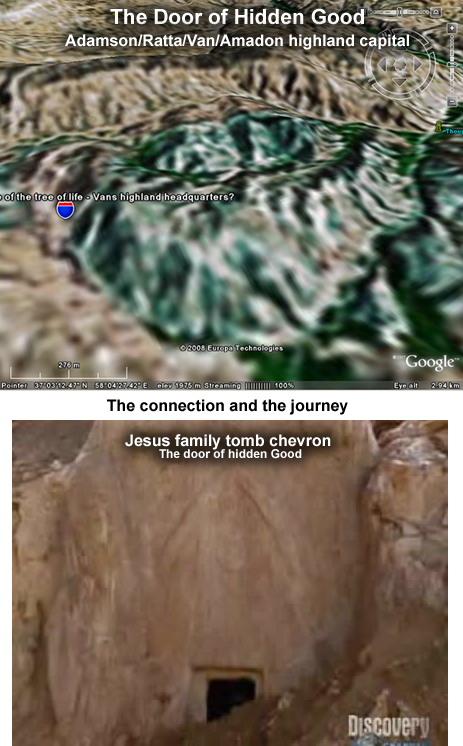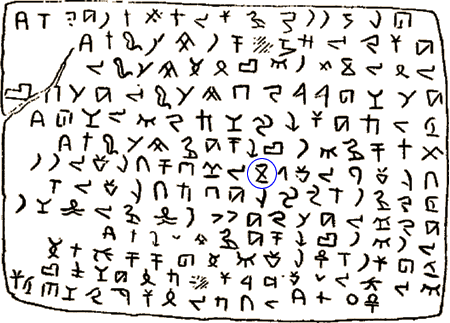
Elamite script
http://www.ancientscripts.com/elamite.html
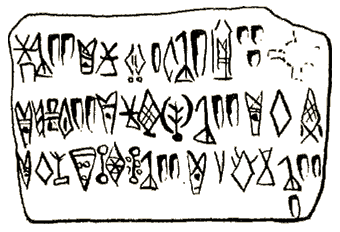

Jiroft script Central Nodite Andite script 11,000 years old found near the Persian Heads. Note the triangle and circle symbol
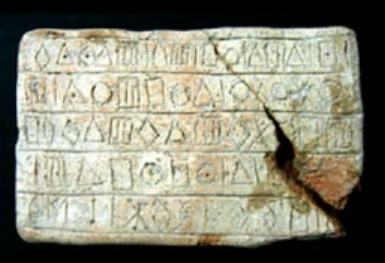
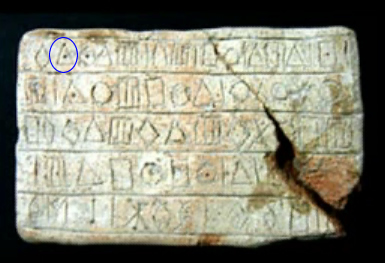
http://www.ancientscripts.com/luwian.html
Literacy appeared during the Bronze Age in Anatolia (which corresponds to modern-day Turkey) in two very different ways. On one hand, the cuneiform writing system of Mesopotamia was adopted to write the Hittite language. On the other hand, an indigenous writing system was invented to write the ancient Luwian language.
This script was originally mislabeled as Hieroglyphic Hittite, because it was discovered in the archives of the Hittitle capital of Hattusa (modern Boğazköy), but its decipherment eventually led to the conclusion that the language recorded was not Hittite, but a related language called Luwian. Hittite and Luwian both belonged to Anatolian subgroup of the Indo-European language family. According to Hittite sources, the Luwians were their neighbors, and they formed a kingdom called Arzawa in western and southern Anatolia where Luwian hieroglyphs likely originated. The Hittites adopted both the Luwian language and script for their own use.
Hieroglyphic Luwian was used in the Hittite Empire between 1400 and 1200 BCE in addition to their cuneiform script. After the fall of the Empire, no evidence of Luwian existed for two hundred years. Then, at around 1000 BCE, new "Neo-Hittite" city-states appeared in Southern Anatolia and Northern Syria, and they left many Hieroglyphic Luwian inscriptions between 1000 and 700 BCE as the rulers of these cities were in fact ethnic Luwians but were related by blood to the Hittite aristocracy. Ultimately, the Assyrian Empire destroyed these city states and the Hieroglyphic Luwian tradition came to an end. However, the Luwian language endured, and possibly evolved into Lycian (although it is also possible that Hittite gave rise to Lycian).
The signs of Hieroglyphic Luwian can be divided into two categories: syllabograms which represent sounds, and logograms which represent words and morphemes. Some of the syllabograms are illustrated in the following chart:
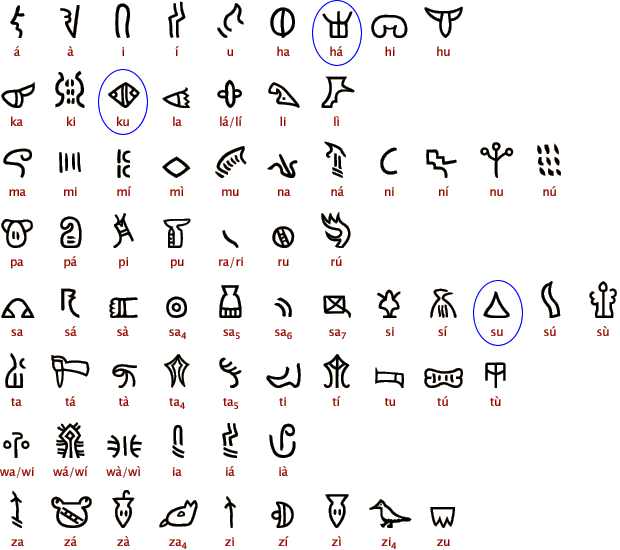
and this chart not the common symbols, the 3 prongs, the Andite heritage seen in symbol and meaning. The triangles and its meaning can be seen and how it translates into our language today.
The following is the list of Luwian logograms. Red text is the Latin transliteration, blue text is English meaning.

Linear B script in Crete and Greece
Again we see similar symbols like the 3 prongs and the use of the triangle.
I believe many of these symbols do have a source point of the original location of Van highland headquarters by the various ancestors that came out of Vans highland home. Many symbols reflect the location such as the triangle and the 3 prongs are related to the Andite migration including the symbols they brought with them in there travels.
http://www.ancientscripts.com/linearb.html
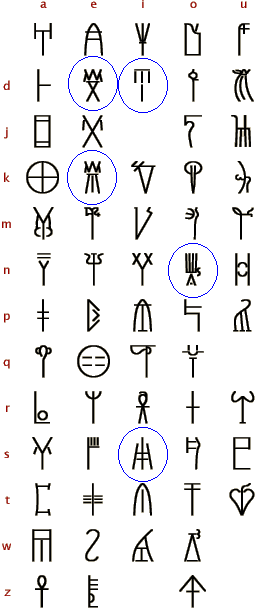
Here is combination of symbols, note the King combinations of symbols. Each symbol within the word has a relevant reflectivity of the location and the source of the symbols which is the Van Adamson highland headquarters.

Understanding that the Cretans and the Greeks were originally, the 2 diverse culture to migrate out of the Van/Adamson highland capital where the tree of life was kept.
Linear A
The oldest example of writing in Crete is a kind of "hieroglyphic" (which means that the signs are picture-like) script. The media where the hieroglyphic inscriptions appeared are mostly clay sealstones.
The origin of the Cretan writing system lies in the extensive use of engraved sealstones, which depict physical objects, to (possibly) record quantities of these objects in soft clay. This forms a natural progression to a systematic writing system.
As time progresses hieroglyphic system became more stylized and more linear. Instead of impressing sealstones in soft clay, the glyphs are incised on the soft clay with a stylus. In addition, quantities are represented by numerals (not multiple impressions of the same sign). As time goes on, it appears that the linear hieroglyphic system evolved into Linear A.
Linear A has roughly 90 symbols, thus most likely a syllabary much like Linear B. However, Linear A has resisted all attempts at decipherment because its underlying language is still unknown and probably will remain obscure since it doesn't seem to relate to any other surviving language in Europe or Western Asia.
Linear B and Cypriot both exhibit considerable similarity to Linear A. Because of its time depth, Linear A appears to be the immediate ancestor to both of these writing systems.
The following is an image of a Linear A tablet.
Encircled we see the same 3 prongs, This script I believe evolved from the original inhabitants of Crete that moved from Vans Capital to the Crete 10,000 years ago and again we see the 3 prong symbol and the tree type symbol. We know that the very early Greeks came from Crete and I believe their symbols then is found in the linear A script found in Greece, the forefathers of Hellenic Greece.

Sumerian Text
In Sumerian text we find similar shapes such as the 3 prongs, the tree and the triangle, another perpetuation of traveling symbols with migration of a related/admixed culture and ancestry.
http://www.ancientscripts.com/sumerian.html
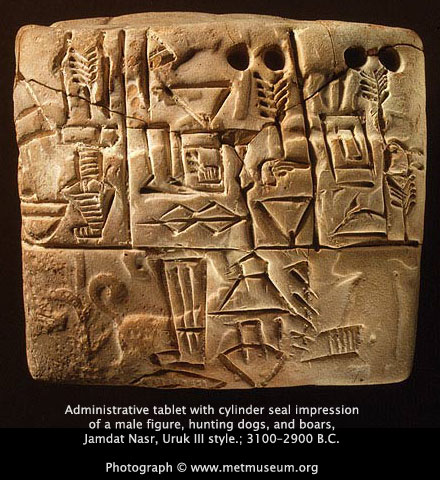
more Sumerian script and its evolution over time.
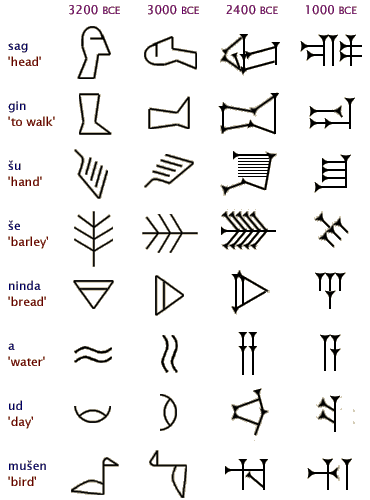
and of course we know that the Andites traveled all over the world spreading there culture and this evidence can be seen in South America amongst the Inca
Close up of the Fuentemagna Bowl. Found in Peru
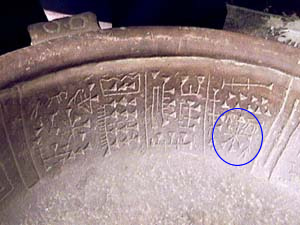
and note this

In script left behind by these traveling Andites mentioned in the Urantia Book.
line 104: One hundred and thirty-two of this race, embarking in a fleet of small boats from Japan, eventually reached South America and by intermarriage with the natives of the Andes established the ancestry of the later rulers of the Incas.
Kulkulkan and the 3 circles is another perpetuation of the Andite culture and evidence that the Incas were visited by white man, bearded Sumerians or Andites.
The legends say that he came from heaven to earth, and because of that he was represented as a feathered serpent in all the ruins of Mexico's archaeological sites. Considered half man and half god in one being, the quetzal bird was chosen as his totem, the bird representing heaven and the serpent representing earth.
White-skinned and bearded, Kukulkan was also the god of life and divine wisdom. He brought love, penitence, and exemption from the usual rituals of sacrifice and blood offering.
He was a mystical being who met with people from distant places, and had the power to heal the sick and bring the dead back to life. When he departed for the east, traveling the ocean on a raft of serpents, he promised his followers that he would return.
He used to say: "ytzeen caan, ytzeen muyal," which in ancient Mayan means: "I am the dew and substance from heaven
Note the Seven circles

Early Hebrew daleth
Its interesting that the triangle is called Daleh, Dala, as in Dalamatia means door and is symbolized by a triangle. Like the first triangle City submerged in the Persian Gulf. Mat or Maat means universal truth or order and tia means regalia.
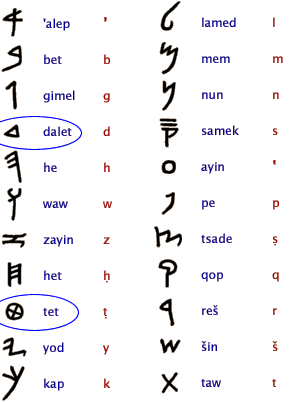
Here is an Hebrew alphabet with all its early variations and with many commonalities.
http://en.wikipedia.org/wiki/Hebrew_alphabet
The word Dalet in Rashi Hebrew has the 7 icon and is associated with the triangle hahaha
![]() Daleh
Daleh
Note this script, the oldest Hebrew Script.

article
http://dsc.discovery.com/news/2008/10/3 ... ng-02.html
Note the Daleh and tet symbol together...Daleh and tet Door and the Tet ??
Tet means the hidden concealed good
The tet is the initial letter of the word tov, "good." The form of the tet is "inverted," thus symbolizing hidden, inverted good--as expressed in the Zohar: "its good is hidden within it." The form of the letter chet symbolizes the union of groom and bride consummating with conception. The secret of the tet (numerically equivalent to nine, the nine months of pregnancy) is the power of the mother to carry her inner, concealed good - the fetus - throughout the period of pregnancy.
http://www.inner.org/HEBLETER/tet.htm
and the triangle means Daleh = door
combine both symbols the door (Daleh) the hidden good (tet)
The door of the hidden Good. This has metaphor to the first city Dalamatia, The door of truth and justice or Daleh Tet, the door of hidden good.

article
http://dsc.discovery.com/news/2008/10/3 ... ng-02.html
Note the Daleh and tet symbol together...Daleh and tet Door and the Tet ??
Tet means the hidden concealed good
The tet is the initial letter of the word tov, "good." The form of the tet is "inverted," thus symbolizing hidden, inverted good--as expressed in the Zohar: "its good is hidden within it." The form of the letter chet symbolizes the union of groom and bride consummating with conception. The secret of the tet (numerically equivalent to nine, the nine months of pregnancy) is the power of the mother to carry her inner, concealed good - the fetus - throughout the period of pregnancy.
Has strong metaphor to Jesus and his bride, the door of hidden good.
http://www.inner.org/HEBLETER/tet.htm
and the triangle means delah = door
combine both symbols the door (delah) the hidden good (tet)
The door of the hidden Good. This has metaphor to the first city Dalamatia in the journey, The door of truth and justice or Delah Tet, the door of hidden good.
I wouldn't be surprised that the triangle/circle chevron above the
door of Jesus' family tomb means the door to
the hidden good. The Delah and Tet
and Jesus our friends family tomb.
The Chevron, Delah Tet, the door to the hidden
Good.

How timely, praise the Lord.
Sevens
Here is Samaritan Text
note the tet is a triangle

Here is Proto-Sinaitic very close to the oldest Hebrew writing and note Delah and tet is very close symbols to the Hebrew script
Proto-Sinaitic, also known as Proto-Canaanite, was the first consonantal alphabet. Even a quick and cursory glance at its inventory of signs makes it very apparent of this script's Egyptian origin. Originally it was thought that at round 1700 BCE, Sinai was conquered by Egypt, and the local West-Semitic population were influenced by Egyptian culture and adopted a small number of hieroglyphic signs (about 30) to write their own language. However, recent discoveries in Egypt itself have compounded this scenario. Inscriptions dating to 1900 BCE written in what appears to be Proto-Sinaitic were found in Upper Egypt, and nearby Egyptian texts speak of the presence of Semitic-speaking people living in Egypt.
http://www.ancientscripts.com/protosinaitic.html
and the Phoenician link with a similar script and with the same meanings
http://www.ancientscripts.com/phoenician.html
Berbian Text
A now look at this script and note the inverted double triangle connected. We know the Andites populated the Berbian territory thousands of years ago. Note the double triangle, the 3 prongs all reminiscent of the original homeland capital in North Western Iran near the Caspian Sea.
http://www.ancientscripts.com/berber.html
The "Berber" script has a very interesting story behind it. Ancient Berber is thought to have sprung off the Punic script roughly around the 6th century BC. It was used throughout North Africa until the 3rd century AD. Strangely though, the inscriptions remain unread, as linguists cannot link the written language to any of the dozen modern Berber languages spoken in North Africa. However, it is widely accepted by scholars that it was a Berber language given the continuity of the population.
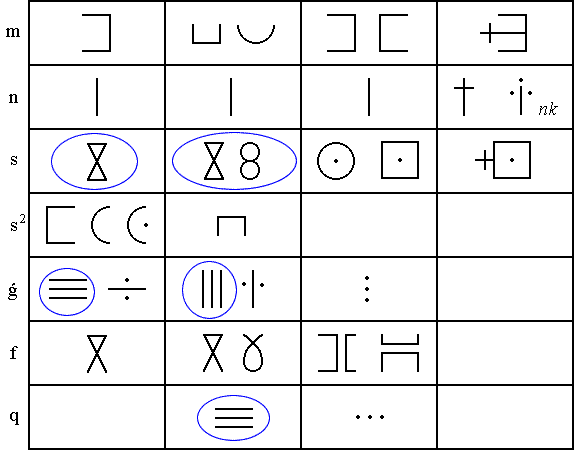
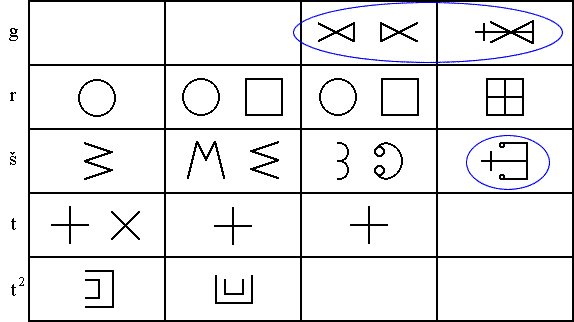
Aramaic
The Aramaic language was the international trade language of the ancient Middle East. Originated in what is modern-day Syria, between 1000 and 600 BCE it became extremely widespread, spoken from the Mediterranean coast to the borders of India. Its script, derived from Phoenician and first attested during the 9th century BCE, also became extremely popular and was adopted by many people, both with or without any previous writing system.
http://www.ancientscripts.com/aramaic.html
The following is the Aramaic script:

Aramaic retains similar symbolism in script to the early Andite languages of the past
Daleh and tet or D and T have the same symbol.
Faliscan
The following is the Faliscan alphabet
http://www.ancientscripts.com/images/faliscan.gif

Looking at it from a Delah and tet symbolism we see the D reflecting Delah Door with a D symbol similar to a triangle with and T reflected in the cross like in the Tet symbol. The door of hidden Good. Little speculation but interesting.
Note Theta and Delta looking at it from the Delah/Door and Tet/hidden good symbolism. Delta/Delah/Door have the triangle symbol and Theta/Tet/hidden good have the same circle and cross symbolism also is the 3 pronged icon which is reflective of the Jet stone icon found at Adonia/Anau. All these features are iconic that have reflection to the inhabitants of Vans capital and from all the Sons of Adamson after the rulership of Van. Van symbols are reflected in the symbolism of the icons in the script of many civilizations of the past that go back thousands of years..
http://www.ancientscripts.com/greek.html
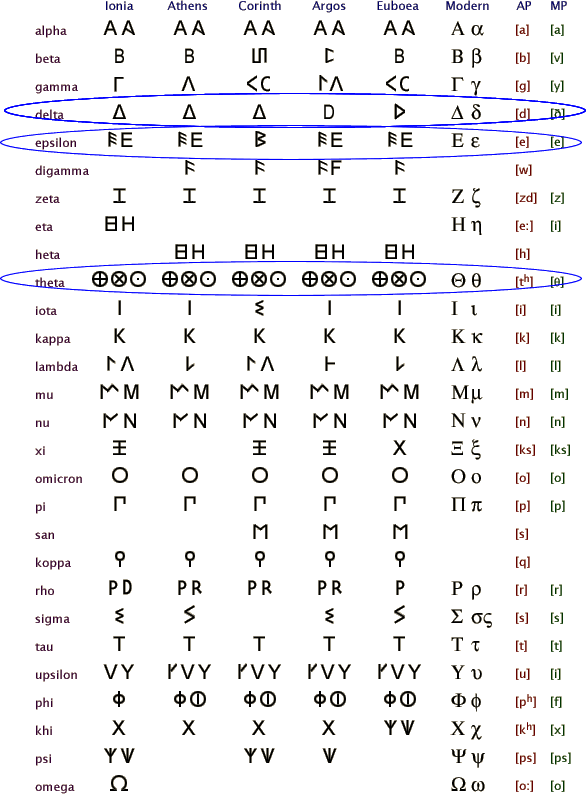
Moving along
http://www.inner.org/HEBLETER/tet.htm
The Hebrew Letters
Dalet: Selflessness
The Talmud describes a situation where one man is carrying a heavy object and another man appears to be helping him by placing his hands under the object, when in truth the first man is carrying all the weight. The second man is referred to as "a merely apparent helper." So are we, explains the Ba'al Shem Tov, in relation to God. Ultimately, all one's strength comes from Above. Free choice is no more than the expression of one's will to participate, as it were, in the Divine act. One merely places one's hands under the weight carried exclusively by God.
"For to You, God, is kindness, for You pay man in accordance with his deed." The Ba'al Shem Tov observes: Just payment in accordance with one's deed is not an act of kindness (chesed), but rather one of judgment (din)! He answers: "in accordance with one's deed," can be read "as though the deed is his." Thus God's ultimate kindness is His enclothing the "undeserved" reward in the guise of deservedness, so as not to shame the receiver. The Name of God in this verse is Adnut, the letters of which also spell in Hebrew dina, "judgment," implying the Divine guise of judgment, through which God's kindness (chesed) is most fully expressed. The Zohar reads chesed as chas dleit, "having compassion [on] the dalet," i.e. he who possesses nothing of his own.
NAME
Door; poor man; lifting up - elevation.
line 134: The remnants of this, one of the oldest civilizations, are to be found in these regions of Mesopotamia and to the northeast and northwest. But still older vestiges of the days of Dalamatia exist under the waters of the Persian Gulf, and the first Eden lies submerged under the eastern end of the Mediterranean Sea.
5 or many locations, the telling us directly locations to be discovered and are found.
and
PAPER 79 - ANDITE EXPANSION IN THE ORIENT
Asia is the homeland of the human race. It was on a southern peninsula of this continent that Andon and Fonta were born; in the highlands of what is now Afghanistan, their descendant Badonan founded a primitive center of culture that persisted for over one-half million years. Here at this eastern focus of the human race the Sangik peoples differentiated from the Andonic stock, and Asia was their first home, their first hunting ground, their first battlefield. Southwestern Asia witnessed the successive civilizations of Dalamatians, Nodites, Adamites, and Andites, and from these regions the potentials of modern civilization spread to the world.
Afghanistan is given as point of reference. pointing Southwest of Afghanistan points directly to the Dalamatia City and the general locations of all the submerged places.

and
Andon is the Nebadon name which signifies "the first Fatherlike creature to exhibit human perfection hunger." Fonta signifies "the first Sonlike creature to exhibit human perfection hunger." Andon and Fonta never knew these names until they were bestowed upon them at the time of fusion with their Thought Adjusters. Throughout their mortal sojourn on Urantia they called each other Sonta-an and Sonta-en, Sonta-an meaning "loved by mother," Sonta-en signifying "loved by father." They gave themselves these names, and the meanings are significant of their mutual regard and affection.
Andon and Fonta were translated.
and
These Andonites avoided the forests in contrast with the habits of their nonhuman relatives. In the forests man has always deteriorated; human evolution has made progress only in the open and in the higher latitudes. The cold and hunger of the open lands stimulate action, invention, and resourcefulness. While these Andonic tribes were developing the pioneers of the present human race amidst the hardships and privations of these rugged northern climes, their backward cousins were luxuriating in the southern tropical forests of the land of their early common origin.
I reckon around the highlands of Srinigar in the huge valley
sevens
I couldn't find the place but I found this park near the republican palace and found this symbolism that relates completely to this on the run journey in symbols and what it means.
Hey by the way when I was opening Google to find this place it was 11:11 on the clock. No joke I had a laugh!
haha
synchronicity!
here is the park symbols
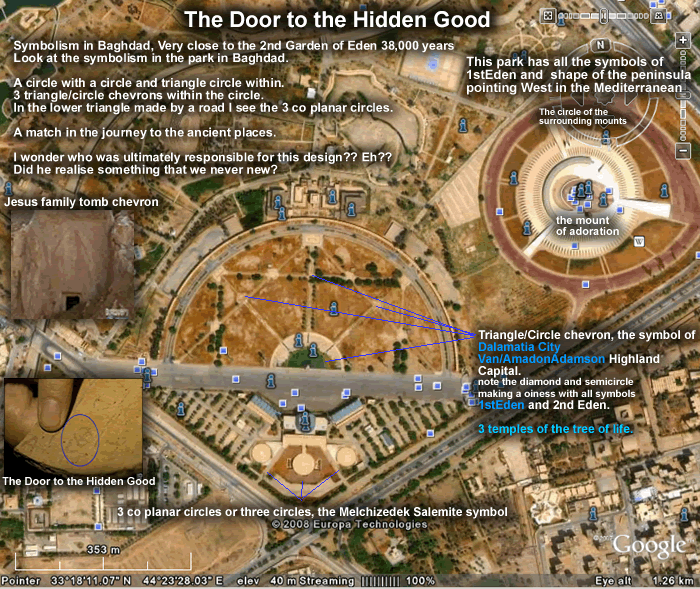
http://www.dalamatiacity.com/triangleChevron.htm
with links
and here is some interesting symbols found on a wider view.
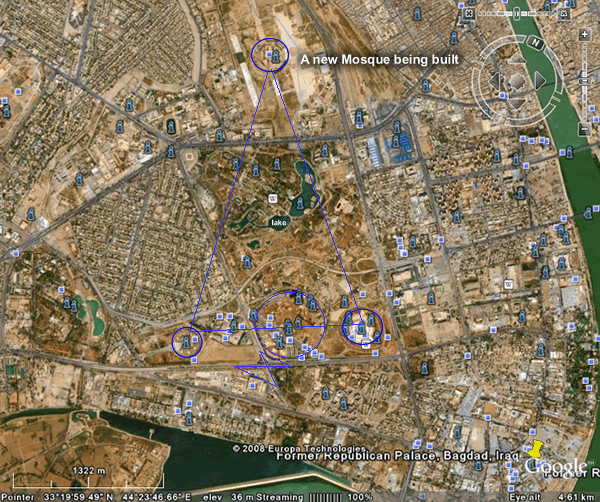
How interesting!
The close up of the park encapsulating all the symbols of the journey.
time 2:11
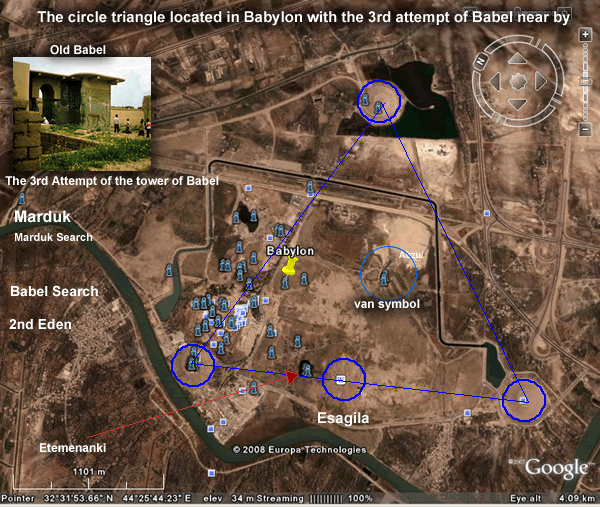
http://www.dalamatiacity.com/ParkTriangle.gif
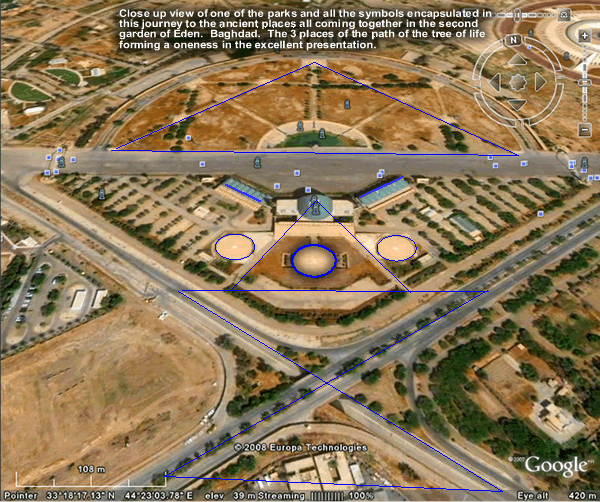

http://www.dalamatiacity.com/triangleBabel.htm
with links
The Ésagila, a Sumerian name signifying "É (temple) whose top is lofty", (literally: house of the raised head) was a temple dedicated to Marduk, the protector god of Babylon. It lay south of the ziggurat Etemenanki, a memory of which has been perpetuated in Judeo-Christian culture as the Tower of Babel.
In this temple was the cult image inhabited by Marduk, surrounded by cult images of the cities that had fallen under the hegemony of the Babylonian Empire from the 18th century BC; there was also a little lake which was named Abzu by the Babylonian priests. This Abzu was a representantion of Marduk's father, Enki, who was god of the waters and lived in such Abzu.i
The Esagila complex, completed in its final form by Nebuchadrezzar II (604-562 BC) encasing earlier cores, was the center of Babylon. It comprised a large court (ca. 40 by 70 meters), containing a smaller court (ca. 25 x 40 m), and finally the central shrine, consisting of an anteroom and the inner sanctum which contained the statues of Marduk and his consort Sarpanit.
According to Herodotus, Xerxes had a statue removed from the Esagila when he flooded Babylon in 482 BC, desecrated the Esagila and sacked the city. Alexander the Great ordered restorations, and the temple continued to be maintained throughout the second century BC, as one of the last strongholds of Babylonian culture, such as literacy in the cuneiform script, but as Babylon was gradually abandoned under the Parthian Empire, the temple fell into decay in the first century BC.
Under the enormous mass of debris that lay over it, Esagila was rediscovered by Robert Koldewey in November 1900, but it did not begin to be seriously examined until 1910. The rising water table has obliterated much of the sun-dried brick and other oldest material. Most of the finds at Babylon reflect the Neo-Babylonian period and later. Data from the Esagila tablet, copied from older texts in 229 BC, have aided in its reconstruction. The tablet, described by George Smith in 1872, disappeared into private hands before it resurfaced and began to be interpreted.
sounds like a very holy place throughout the ages.
Notw , in truth Babel was a perpetuation of ultimately the Nodite culture,
fallen sons of God they perpetuated the symbols of Dalamatia through
Dilmun and through the Andites of Late.
Sevens
Little do they realize wireless
and i am that I am how close we are. This is becoming swift!
Sevens
time 3.33
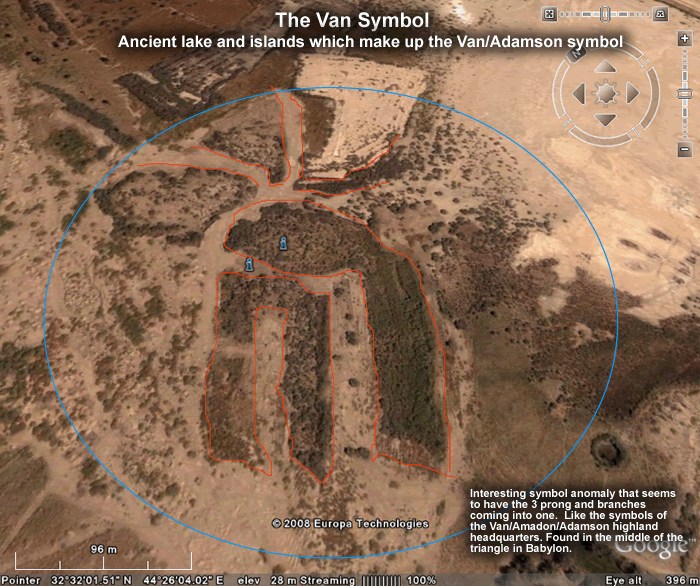
http://www.dalamatiacity.com/triSymbol.htm
with links
Sevens
This appears to be the site of
the Ziggurat of Marduk/Adam or some seem to think it is the site the
fabled Babel, the 3rd attempt.
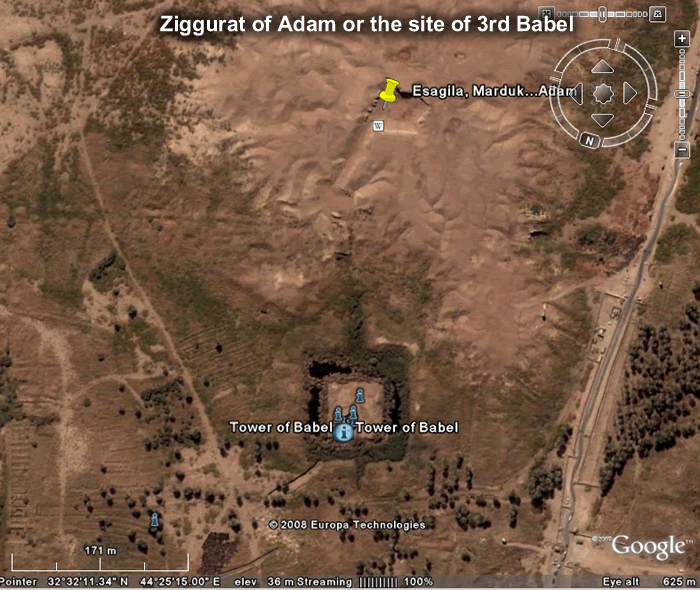
Sevens
Google Earth
Sevens
![]() Re:
Barack Hussein Obama and the Triumph of Marxism
Re:
Barack Hussein Obama and the Triumph of Marxism
Actually I think the blend of socialism and capitalism works
quite ok like it does in this country.
There is a safety net for the people in case things go wrong and it works
quite good. We see less people on the streets and people do feel more
secure. This is the benefits of a socialized system with capitalism and
democracy with stability and where all vote to find the thoughts of the
people. So all have a say!
Why people dont vote or participate is because they have no faith in the
system that afflicts and at the same time waxes fat on the land.
We do live in Baalim system where some of its tenants is ownership of land
(real estate) and fertility. No different to what we see today in full
character and since when is a Baalim system loving and unconditional?? Eh!
All man has put his faith, energy and his money in the System of Baal!
Man cant even survive without Baal and his system. The Baal system and its
truth taught worldwide is the AntiChrist system and all people and there
religions participate with Baal and his knowledge to bring about the
material riches.
The way you think is either influence by Baal or the Father, the opposites, the greatest difficulty is serving 2 masters, one for material sustenance and the other master of truth in a system that has no belief in the Father in the Kingdom of Heaven and where the tenants are the opposite and bring about compromise. The Jesus message today is compromised by religions who participate with Baal through materialism, commerce and politics.
When the full Seventh message is given and completed, all the churches will deny the final stand in truth because they are to bound to Baal and his systems of operations.
For the churches its a real dilemma with real perplexity! in
the end times it will require real faith from the leaders of the churches,
faith I dont believe they have because of the quagmire of commerce and
politics they are involved in. The Fathers message is getting stronger with
definition and all will ignore because they will be unable to make the real
faith decisions that the end times will require.
Sevens
Correction be aware at all times by particularly around Dec
3rd 08
Ive been finding many outstanding things that goes right Old Babylon and
early Sumerian culture in Symbolism, the end time journey is all about
connection the symbols and the journey along the way. All will deny of
course!
I think we are at the doors of judgment.
It must be close to what I'm finding. I'm following Daniel end time timeline
and everything is beautiful. Paradise is very beautiful in its great message
for our time today.
Sevens8
I believe we are in the end times and no matter who is in it will be very challenging.
All the best to him and for the American people. I hope they do well and recover under the new leadership.
Sevens
In the image, note the 3 co planar circles and the ring he holds. The 3 circles is the symbol of the Salemite Melchizedek priests.
Isn't that similar to NeZha, the Chinese boy God who slays the dragon with his ring Like what we find in Revelation regarding the dragon.
All the same features of a prophecy which I believe is perpetuating now. The three rings will slay the Dragon in truth.
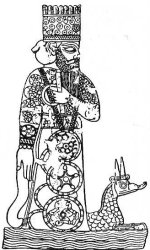
Esagila
Quote:Esagila or Esagil (Sumerian, 'The house that rises its head'): temple of the Babylonian supreme god Marduk
http://www.livius.org/es-ez/esagila/esagila.html
All the best
Sevens
"The house that rises its head"
That is the message that I interpret that comes from this temple of Marduk
in the journey following the symbols from the ancient places.
I believe this is the case and the journey to how I got there is a live
testament. The meaning Esagil, "The house that rises its head" would be the
message from Marduk, and is the metaphor for the symbols found in Baghdad
and from ancient Babylon of all places. Just the fact of finding Marduk,
Adam in perpetuation at the end of this phase of the journey is incredible
for me.
Marduk wearing the 3 rings with his ring stamp of approval, it just feels
like that finding him through the door of hidden good and "The
house that rises its head" following the triangle chevron and all the
associated symbols.

quote:
with the Hebrews it was, in general, Adam's return as a material ruler. In Babylon the god Marduk was a perpetuation of the Adam legend, the son-of-God idea, the connecting link between man and God. Following the appearance of Adam on earth, so-called sons of God were common among the world races.
Marduk from the UB
and
Marduk Search
Lets see where this leads to
"the door of hidden good" Jesus
"The house that rises its head" Adam
Sevens
Following all the symbols has led me to Baghdad and Ancient Babylon.
The triangle chevron symbol and the 3 co planar circles has led me to
Marduk who is a perpetuation of Adam as my research led me.
The message I interpret from the symbol I have been following connected to
Jesus' family tomb is
"the door of hidden good" Jesus
The symbol of the 3 circles which led me to the temple of Marduk, Esagila
from ancient Babylon bares the message
"The house that rises its head" Marduk/Adam
In context to my journey to the ancient places being led by all the
relevant symbols could only mean judgment, as spoken in ancient prophecy.
I would be prepared or very aware as a great change may happen as I find
these things. What Im finding is all in context and it relates to the
planet. I sincerely believe that the end will come from the beginning from
paths not known as foreseen. The truth will come from the first places and
everything will work in parallel as we realize many things along the way.
Anyway all the best but that is what Im finding in the journey to the very
first places. I share this because we have to be together as judgment
approaches and everyman will accounted of his works and individual faith.
The 7 or 10 commands of conduct in faith or Love for one another is the
only guide on how to live our lives at the doors of judgment.
I heard a caption of an Islamic Mufti on TV and he said "the only to
vanquish an enemy is to make him your friend". How true is that, I was
inspired.
Sevens8
That is the message that I interpret that comes from this temple of Marduk in the journey following the symbols from the ancient places.
I believe this is the case and the journey to how I got there is a live testament. The meaning Esagil, "The house that rises its head" would be the message from Marduk, and is the metaphor for the symbols found in Baghdad and from ancient Babylon of all places. Just the fact of finding Marduk, Adam in perpetuation at the end of this phase of the journey is incredible for me.
Marduk wearing the 3 rings with his ring stamp of approval, it just feels like that finding him through the door of hidden good and "The house that rises its head" following the triangle chevron and all the associated symbols.

Marduk from the UB
and
Marduk Search
Lets see where this leads to
Another big message from Esagila in context to my journey is
"the door of hidden good" Jesus
"The house that rises its head"
Adam
"House of the foundation of heaven on
earth" E-temen-an-ki, The Father (in metaphor)
Note the temple has Seven levels
and a large triangle in the face of it
and 3 doors.
Is that the messages? Is that the 3 messages from the
3 doors of hidden good.
E-temen-an-ki

Measurements of the Seven Levels
2nd step 260ft by 260ft 60ft high
3rd step 200ft by 200ft 20ft high
4th step 170ft by 170ft 20ft high
5th step 140ft by 140ft 20ft high
6th step ? 20ft high?
7th step 70ft by 80ft 50ft high
Dimensions of the Babylonian Ziggurat
http://www.livius.org/es-ez/etemenanki/etemenanki.html
A reconstruction of the Etemenanki
Esagila
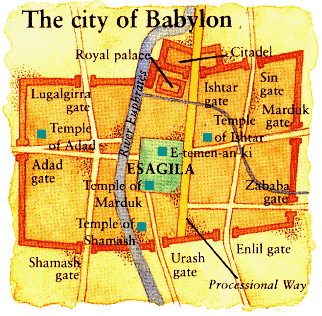
Sevens
Im interested in the Temple of
E-temen-an-ki
I noted the word Temen. I just wonder if this related to what Habukkak
mentions?
This world teman, temen, tema seems to be common. I just wonder if its
related to this temple having temen, teman in its name.
Here is an old study on Teman, Tema it covers a few books. Before all the
other places where discovered.
http://www.dalamatiacity.com/eden/book_dead.htm#tem
Sevens
Im interested in the Temple of
E-temen-an-ki
I noted the word Temen. I just wonder if this related to what Habakkuk
mentions?
This world teman, temen, tema seems to be common. I just wonder if its
related to this temple having temen, teman in its name.
Here is an old study on Teman, Tema it covers a few books. Before all the
other places where discovered.
Here is an old link in the early days
http://www.dalamatiacity.com/eden/book_dead.htm#tem
Having re read the link I find things could be expanded but there appears to
be much end times information surrounding Tem from Teman. Maybe perhaps E-temen-an-ki
from ancient Babylon near the 2nd Garden of Eden, having embedded in its
name, temen could be related to prophecy? Maybe in this journey and what is
uncovered along the way.
Sevens
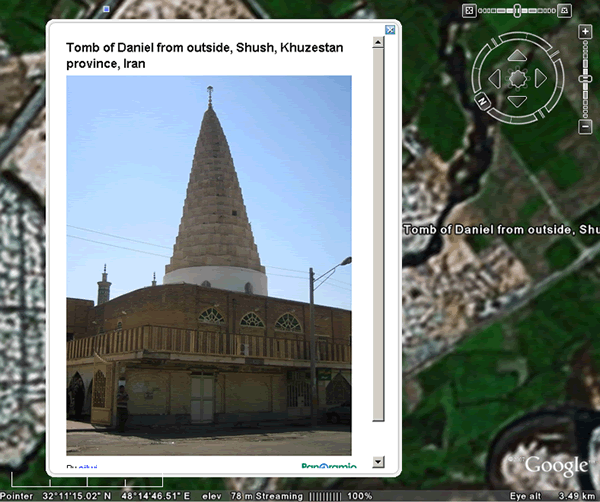
3 semi-circles and the circular cone pillar above and between but has a triangle look.
"The house that rises its head" Im working with Daniels timeline and the 1335th day finishes on Dec 3rd 08
Sevens
(Hey Cyrus check it out hahaha)
No worries
There are cameras available on the market where photos can be taken in infra
red. Some Video camera have that function.
How about get a video camera with heaps of memory and use the infra red
facility on a night long shoot if possible. I reckon you would get better
results. Apparently you can see UFOs using this infra red facility.
Here are some tips
http://www.paranormal-investigation.com/research/nightshot/nightshot.htm
Good Luck and Good Hunting.
All the best
Sevens
That is quite possible.
However there should be something that should very unusual like an event
which would prove otherwise.
Ahh see what happens I would like to test these things whether is data
matching thought or guidance.
Sevens
Im not sure whether the Bacchanalian Society received full satisfaction
being pre occupied on the day (Sept 18th) when the world lost a few
trillion or maybe they just opted for a few stiff drinks instead.
Cheers
Sevens
Abbes = mothers maiden name
Ab = (the Abzu from Ab=water and Zu=far)
http://www.answers.com/topic/sumer
Eridu, on the other hand, was the home of the culture god Enki (absorbed into Babylonian mythology as the god Ea), the god of beneficence, ruler of the freshwater depths beneath the earth (the Abzu from Ab=water and Zu=far), a healer and friend to humanity who was thought to have given us the arts and sciences, the industries and manners of civilization; the first law-book was considered his creation. Eridu had once been a seaport, and it was doubtless its foreign trade and intercourse with other lands that influenced the development of its culture.
To illustrate, es means house, es-gnnu means city, i.e., many houses; igi means eye,
Abbes in Sumerian meanings
"Water House" with
gnnu added to
Abbes means "city"
Abbes.gnnu = "Water City"
Water City
To me this has relevance to the Dalamatia City, 1stEden and Dilmun. All Water Cities!
The surname Abbes has all the right metaphor to the ancient submerged
water cities. It is in the name.
i. A theory has recently been put forward by Dr. Delitzsch, who, while
re-
cognising the pictorial origin of certain signs, attempts to explain the
rest as
formed from them artificially. Instances have been given above of how new
signs were formed by combinations of signs already in existence, but Dr. De-
litzsch goes further and asserts that new signs were formed by combinations
and variations of simple wedges or rather lines. He distinguishes some
forty-
five Urbilder or signs with a "motive" and thinks the majority of the
characters
were developed from them. Of the methods of combination he sets forth the
most convincing is that in which the meaning of a simple sign was
intensified
by the addition of a number of extra wedges ; this process the Sumerians
termed gnnu. Few people will, however, accept his theory in its
present form.
Looking into Abb
http://www.answers.com/topic/abb
The Abbreviation for Abb as in the Abbes is
Post
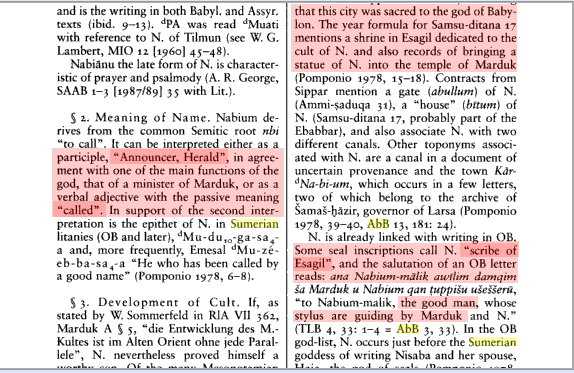
with Links
http://www.dalamatiacity.com/MardukMessage.htm
So brilliant to see confirmation in what I already thought.
Marduk relates to Adam and Jesus is the 2nd Adam or the 2nd Marduk guiding this stylus!
The scribe of Esagil working with Marduk/Adam/Jesus guiding the stylus.
Wow! just the thought of it!
Quote:Two great towers
to discern the two great gods
I built in the House of Brilliance -
a place for their joy,
a place for their pride -
a brilliance of the stars of the heaven.
With the master-builders artfulness,
with my own planning and exertions,
the insides of the temple I made splendid.
In its midst I made a place for the
rays directly from the heavens,
in the walls I made the stars to appear.
I made their brilliance great,
the towers I made to rise to the sky.
Praise the Lord Father in the Kingdom of Heaven.
Sevens
The symbol of the Salemite priesthood at the entrance, this could depict Etemmenanki or the Temple of Marduk is the Esagila.

http://www.bibliotecapleyades.net/sitchin/whentimebegan/images/whenti45.jpg
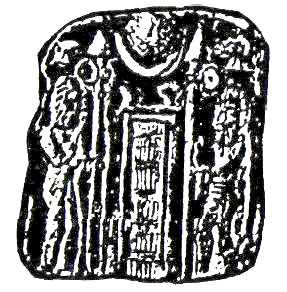
No one really knows the 3 circles mean, but we do!
You can a similar thing on the elevated circle at the entrance above the
odd shape and the 2 circles on top of the guard staves beside the doorway.
The 3 coplanar circles, the coplanar circles go directly back to 1stEden
and perpetuated through to 2nd Eden.
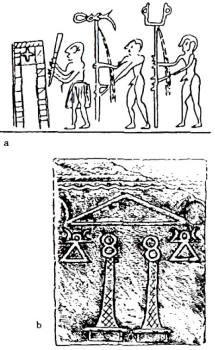
the above image has interesting symbols
There they adopted as their main divine symbol the depiction of an astronomical instrument; before it began to appear on stelae and even tombstones, it was shown in association with two double-ringed pillars that flanked the entrance to a temple (Fig. 65b) - as earlier in Mesopotamia. The ring flanked by two opposite facing crescents suggests observations of the Sun and of the Moon's phases.
In the following the 3 CoPlanar circles
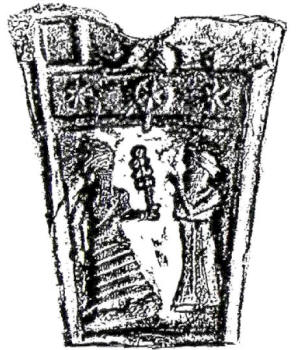
Sevens
Akkadian
For the name of this building, É - a r at t a - k i - s _ a' r - r a, "house, mountain of the entire world" 53 emphasized the idea that the "connection between heaven and earth" was located here
http://www.gatewaystobabylon.com/religion/ancientcapitals.htm
As the author of a three-volume history of Mesopotamia and a leading Iranian authority on the third millennium BC, Madjidzadeh has long hypothesized that Jiroft is the legendary land of Aratta, a lost Bronze Age kingdom of renown. Its a quest that he began as a doctoral candidate at the University of Chicago, when in 1976 he published an article proposing that Aratta, which reputedly exported its magnificent crafts to Mesopotamia, was located somewhere in southeastern Iran.
http://www.cais-soas.com/CAIS/Archaeology/Pre-History/jiroft.htm
Remebering the Adamson and Ratta did settle in the Van highland Capital, I wonder if Ratta, Adamsons wife name perpetuated in being named Aratta, the Kingdom Aratta named after Ratta where A stands for Adamson, Aratta. The Kingdom of Adamson and Ratta....ARATTA
Here is a search for Ratta in the Urantia Book which may guide us into more understanding about the Kingdom of Aratta.
Ratta
http://www.urantia.org/cgi-bin/webglimpse/webglimpse/usr/local/www/data/papers?query=Ratta
I believe Aratta is here, the home of Adamson and Ratta near the Kopet Daugh in the Highland close to Adonia/Anau

Can you see the 3 circles from Jiroft.
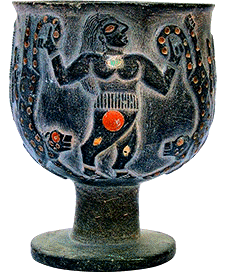
Sevens
Enmerkar and the lord of Aratta: translation
http://www-etcsl.orient.ox.ac.uk/section1/tr1823.htm
1-24City, majestic bull bearing vigour and great awesome splendour, Kulaba, ......, breast of the storm, where destiny is determined; Unug, great mountain, in the midst of ....... There the evening meal of the great abode of An was set. In those days of yore, when the destinies were determined, the great princes allowed Unug Kulaba's E-ana to lift its head high. Plenty, and carp floods, and the rain which brings forth dappled barley were then increased in Unug Kulaba. Before the land of Dilmun yet existed, the E-ana of Unug Kulaba was well founded, and the holy jipar of Inana in brick-built Kulaba shone forth like the silver in the lode. Before ...... carried ......, before ......, before ...... carried ......, before the commerce was practiced; before gold, silver, copper, tin, blocks of lapis lazuli, and mountain stones were brought down together from their mountains, before ...... bathed for the festival, ......, ...... time passed.
2 lines missing
The above fragment must be about Dalamatia City, the of the Sons of God. This is the City before the times of Dilmun which was built 50,000 years after the rebellion of Lucifer 150,000 years from our time "Before the land of Dilmun yet existed" Dilmun and its first Tower of Babel was envisioned as being a great place for commerce and trade. Referenced "before the commerce was practiced;" Dalamatia City and its walls was made out of brick, a high quality brick. Dalamatia City was probably called Kulaba where the temple of the tree of life was as referenced as Jipar "the holy jipar of Inana in brick-built Kulaba"
From a Urantia perspective, the above would be speaking about Dalamatia City in description being before Dilmun however in the following I believe it would be speaking about Adamson and Ratta in there highland home in North Eastern Iran near the Kopet Daugh. Lets look at some fragments.
38-64"My sister, let Aratta fashion gold and silver skilfully on my behalf for Unug. Let them cut the flawless lapis lazuli from the blocks, let them ...... the translucence of the flawless lapis lazuli ....... ...... build a holy mountain in Unug. Let Aratta build a temple brought down from heaven -- your place of worship, the Shrine E-ana; let Aratta skilfully fashion the interior of the holy jipar, your abode; may I, the radiant youth, may I be embraced there by you. Let Aratta submit beneath the yoke for Unug on my behalf. Let the people of Aratta bring down for me the mountain stones from their mountain, build the great shrine for me, erect the great abode for me, make the great abode, the abode of the gods, famous for me, make my me prosper in Kulaba, make the abzu grow for me like a holy mountain, make Eridug gleam for me like the mountain range, cause the abzu shrine to shine forth for me like the silver in the lode. When in the abzu I utter praise, when I bring the me from Eridug, when, in lordship, I am adorned with the crown like a purified shrine, when I place on my head the holy crown in Unug Kulaba, then may the ...... of the great shrine bring me into the jipar, and may the ...... of the jipar bring me into the great shrine. May the people marvel admiringly, and may Utu witness it in joy."
69-104"Come, Enmerkar! I shall offer you advice: let my counsel be heeded. I shall speak words to you; let them be heard. Choose from the troops as a messenger one who is eloquent of speech and endowed with endurance. Where and to whom shall he carry the important message of wise Inana? Let him bring it up into the Zubi Mountains, let him descend with it from the Zubi Mountains. Let Susin and the land of Ancan humbly salute Inana like tiny mice. In the great mountain ranges, let the teeming multitudes grovel in the dust for her. Aratta shall submit beneath the yoke to Unug. The people of Aratta shall bring down the mountain stones from their mountains, and shall build the great shrine for you, and erect the great abode for you, will cause the great abode, the abode of the gods, to shine forth for you; will make your me flourish in Kulaba, will make the abzu grow for you like a holy mountain, will make Eridug shining for you like the mountain range, will cause the abzu shrine to shine forth for you like the glitter in the lode. When in the abzu you utter praise, when you bring the me from Eridug, when, in lordship, you are adorned with the crown like a purified shrine, when you place on your head the holy crown in Unug Kulaba, then may the ...... of the great shrine bring you into the jipar, and may the ...... of the jipar bring you into the great shrine. May the people marvel admiringly, and may Utu witness it in joy. Because ...... shall carry daily, when ...... in the evening cool ......, -- in the place of Dumuzid where the ewes, kids and lambs are numerous, the people of Aratta shall run around for you like the mountain sheep in the akalag fields, the fields of Dumuzid. Rise like the sun over my holy breast! You are the jewel of my throat! Praise be to you, Enmerkar, son of Utu!"
It appears that Aratta and its people live in a great mountain range. This would fit the description of the Van/Adamson headquarters, their highland capital.
another fragment
108-133"You shall bring it up into the Zubi Mountains, you shall descend with it from the Zubi Mountains. Let Susin and the land of Ancan humbly salute Inana like tiny mice. In the great mountain ranges, let the teeming multitudes grovel in the dust for her. Messenger, speak to the lord of Aratta and say to him: "Lest I make the people fly off from that city like a wild dove from its tree, lest I make them fly around like a bird over its well-founded nest, lest I requite (?) them as if at a current market rate, lest I make it gather dust like an utterly destroyed city, lest like a settlement cursed by Enki and utterly destroyed, I too utterly destroy Aratta; lest like the devastation which swept destructively, and in whose wake Inana arose, shrieked and yelled aloud, I too wreak a sweeping devastation there -- let Aratta pack nuggets of gold in leather sacks, placing alongside it the kumea ore; package up precious metals, and load the packs on the donkeys of the mountains; and then may the Junior Enlil of Sumer have them build for me, the lord whom Nudimmud has chosen in his sacred heart, a mountain of a shining me; have them make it luxuriant for me like a boxwood tree, have them make its shining horns colourful for me as when Utu comes forth from his chamber, have them make its doorposts gleam brightly for me." "
"Lest I make the people fly off from that city like a wild dove from its tree, lest I make them fly around like a bird over its well-founded nest, Speaks of a city and references a tree I wonder if this in metaphor refers to the location of the tree of life, "its well-founded nest," seems to suggest a well founded city of renown and of great reputation. A city of a great myth and legend.
Aratta is definitely a city in the mountains
156-157The lord added further instructions for the messenger going to the mountains, to Aratta:
Suggest North with the south wind behind, Aratta appears to be some days away.
158-159"Messenger, by night, drive on like the south wind! By day, be up like the dew!"
160-175The messenger gave heed to the words of his king. He journeyed by the starry night, and by day he travelled with Utu of heaven. Where and to whom will he carry the important message of Inana with its stinging tone? He brought it up into the Zubi Mountains, he descended with it from the Zubi Mountains. Susin and the land of Ancan humbly saluted Inana like tiny mice. In the great mountain ranges, the teeming multitudes grovelled in the dust for her. He traversed five mountains, six mountains, seven mountains. He lifted his eyes as he approached Aratta. He stepped joyfully into the courtyard of Aratta, he made known the authority of his king. Openly he spoke out the words in his heart. The messenger transmitted the message to the lord of Aratta:
So its 5 - 7 Mountain ranges away to the North "He traversed five mountains, six mountains, seven mountains."
I checked Google and I could count 7 major mountains ranges if not more. If you went North East from Etemenanki, Babylon, Esagila it would be North East to Aratta, The Van highland headquarters and the home of Adamson and Ratta, ARatta
You would follow North East to Arbil then cut across to the plateau to the Caspian Sea, At the Caspian you would go to the East Along the Atrek past Bonjourd in that narrow valley and then to right at the circle to the highland triangle valley of Van/Adamson/Ratta, the Kingdom of Aratta.
Note the Atrek river = like, A = Adamson Adamsons trek, the Atrek river.
The Atrek ran though the Kingdom of ARatta.
Why Ratta' name was kept in Aratta because Ratta was worshipped as a Mother Goddess (Mother worship) in ancient times past and the name was upheld in the kingdom. The Kingdom of Aratta.
Here are more reflections
218-226When he had spoken thus to him, (the lord of Aratta replied): "Messenger, speak to your king, the lord of Kulaba, and say to him: "It is I, the lord suited to purification, I whom the huge heavenly neck-stock, the queen of heaven and earth, the goddess of the numerous me, holy Inana, has brought to Aratta, the mountain of the shining me, I whom she has let bar the entrance of the mountains as if with a great door. How then shall Aratta submit to Unug? Aratta's submission to Unug is out of the question!" Say this to him."
I whom the huge heavenly neck-stock reference to advanced genes Adamson being the first son of Adam and Ratta the last of the Progeny of the Sons of God. It makes them literaly "the queen of heaven and earth," She brought to Arratta "has brought to Aratta, the mountain of the shining me," The me being the knowledge of everything. "She brought to Arratta " Infers coming from another location, Adamson did come from 1stEden,2nd Eden and then met and married Ratta in the Van highland capital where the tree of life was kept before 1stEden.
227-235When he had spoken thus to him, the messenger replied to the lord of Aratta: "The great queen of heaven, who rides upon the awesome me, dwelling on the peaks of the bright mountains, adorning the dais of the bright mountains -- my lord and master, who is her servant, has had them instal her as the divine queen of E-ana. Aratta shall bow, O lord, in absolute submission! She has spoken to him thus, in brick-built Kulaba."
"The great queen of heaven, who rides upon the
awesome me," The queen and the me
dwelling on the peaks of the bright mountains"
Live in the home in the peaks of the hill
mountains
"adorning the dais of the bright
mountains" She has a temple/home in the peaks of the
mountains and it adorns the mountains, like a stage . This describes
the triangle temple which looks like a stage surrounded by mountains on all
sides in the Van highland capital, the triangle highland valley, Aratta.
Dais
da·is (d
s, d
-)
n.A raised platform, as in a lecture hall, for speakers or honored guests
http://www.thefreedictionary.com/dais
Look at the following clues that directly reflects the home of the tree of life in Aratta.
242-273"Messenger! Speak to your king, the lord of Kulaba, and say to him: "This great mountain range is a mes tree grown high to the sky; its roots form a net, and its branches are a snare. It may be a sparrow but it has the talons of an Anzud bird or of an eagle. The barrier of Inana is perfectly made and is impenetrable (?). Those eagle talons make the blood of the enemy run from the bright mountain. Although in Aratta there is weeping ......, water libations are offered and flour is sprinkled; on the mountain, sacrifices and prayers are offered in obeisance. With fewer than five or ten men, how can mobilized Unug proceed against the Zubi mountains? Your king is heading in all haste against my military might, but I am equally eager for a contest. (As the proverb goes,) he who ignores a rival, does not get to eat everything up, like the bull which ignores the bull at its side. But he who acknowledges a contest can be the outright winner, like the bull which acknowledges the bull at its side -- or does he reject me in this contest? Like ......, ...... can match no one -- or does he still reject me in this contest? Again, I have words to say to you, messenger: I have an artful proposal to make to you ......, may it get across to you ........ Repeat this to your master, to the lord of Kulaba, a lion lying on its paws in E-ana, a bull bellowing within it, within his jipar, fruitful as a flourishing mes tree. The mountain range is a warrior, ...... high, like Utu going to his abode at twilight, like one from whose face blood drips; or like Nanna, who is majestic in the high heavens, like him whose countenance shines with radiance, who ...... is like the woods in the mountains. " "
a mes tree
The mes
reflects the tree of life, it grows high
roots form a net, and
its branches are a snare, like in the end times, the snare of
truth through the branches. This could also describe the branches that
lead to conjunction in front of the temple, the Dais, the stage for honored
quests.
"Although in Aratta" The temple appears
to be separate from main center of Aratta.
on the mountain" The Temple is on
the mountain and there is very few people, like in the end times when few
will be gathered in the last stand of truth.
jipar, fruitful as a flourishing mes
tree. The mountain range is a warrior
The tree of life, Mes tree is in Dais\temple. The temple is
surrounded by a mountain range. The Dais is set in the peaks but in a
highland valley with mountains surrounding with streams of water running
meeting at the temple point feeding the tree of life and the gardens of the
temple.
The Urantia Book
line 120: Adamson lived for 396 years. Many times he returned to visit his father and mother. Every seven years he and Ratta journeyed south to the second garden, and meanwhile the midwayers kept him informed regarding the welfare of his people. During Adamson's life they did great service in upbuilding a new and independent world center for truth and righteousness.
and
line 121: Adamson and Ratta thus had at their command this corps of marvelous helpers, who labored with them throughout their long lives to assist in the propagation of advanced truth and in the spread of higher standards of spiritual, intellectual, and physical living. And the results of this effort at world betterment never did become fully eclipsed by subsequent retrogressions.
and the location of Aratta
This center of civilization was situated in the region east of the southern end of the Caspian Sea, near the Kopet Dagh. A short way up in the foothills of Turkestan are the vestiges of what was onetime the Adamsonite headquarters of the violet race. In these highland sites, situated in a narrow and ancient fertile belt lying in the lower foothills of the Kopet range, there successively arose at various periods four diverse cultures respectively fostered by four different groups of Adamson's descendants. It was the second of these groups which migrated westward to Greece and the islands of the Mediterranean. The residue of Adamson's descendants migrated north and west to enter Europe with the blended stock of the last Andite wave coming out of Mesopotamia, and they were also numbered among the Andite-Aryan invaders of India.

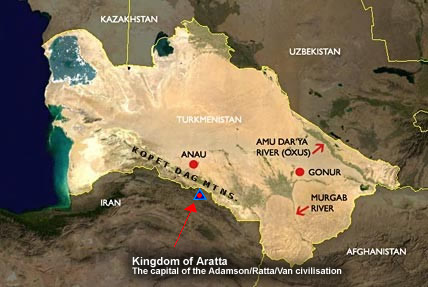
274-280""Now if Enmerkar just makes straight for the ...... of Aratta, for the benevolent protective spirit of the mountain of holy powers, for Aratta, which is like a bright crown of heaven, then I shall make my pre-eminence clear, and he need not pour barley into sacks, nor have it carted, nor have that barley carried into the settlements, nor place collectors over the labourers."
and
281-293""But if he were actually to have barley poured into carrying-nets, and to have it loaded on the packasses at whose sides reserve donkeys have been placed, and were to have it heaped up in a pile in the courtyard of Aratta -- were he really to heap it up in such a manner; and were Inana, the luxuriance of the grain pile, who is the 'illuminator of the lands', the 'ornament of the settlements', who adorns the seven walls, who is the heroic lady, fit for battle, who, as the heroine of the battleground, makes the troops dance the dance of Inana -- were she actually to cast off Aratta as if to a carrion-pursuing dog, then in that case I should submit to him; he would indeed have made me know his preeminence; like the city, I in my smallness would submit to him. "So say to him."
and
308-338After day had broken and Utu had risen, the sun god of the Land lifted his head high. The king combined the Tigris with the Euphrates. He combined the Euphrates with the Tigris. Large vessels were placed in the open air, and he stood small vessels beside them, like lambs lying on the grass. ...... vessels were placed in the open air adjacent to them. Then the king, Enmerkar, the son of Utu, placed wide apart the ecda vessels, which were of gold. Thereupon, the tablet ......, the pointed stylus of the assembly, the golden statue fashioned on a propitious day, beautiful Nanibgal, grown with a fair luxuriance, Nisaba, the lady of broad wisdom, opened for him her holy house of wisdom. He entered the palace of heaven, and became attentive. Then the lord opened his mighty storehouse, and firmly set his great lidga measure on the ground. The king removed his old barley from the other barley; he soaked the greenmalt all through with water; its lip ...... the hirin plant. He narrowed the meshes of the carrying nets. He measured out in full (?) the barley for the granary, adding for the teeth of locusts. He had it loaded on the packasses at whose sides reserve donkeys were placed. The king, the lord of broad wisdom, the lord of Unug, the lord of Kulaba, dispatched them directly to Aratta. He made the people go on to Aratta on their own, like ants out of crevices. Again the lord added instructions for the messenger going to the mountains, to Aratta:
and
339-346"Messenger, speak to the lord of Aratta and say to him: "The base of my sceptre is the divine power of magnificence. Its crown provides a protective shade over Kulaba; under its spreading branches holy Inana refreshes herself in the shrine E-ana. Let him snap off a splinter from it and hold that in his hand; let him hold it in his hand like a string of cornelian beads, a string of lapis lazuli beads. Let the lord of Aratta bring that before me." So say to him."
347-365After
he had thus spoken to him, the messenger went on his way to
Aratta; his feet raised the dust of the road, and made the little pebbles
of the hills thud; like a dragon prowling the desert, he was unopposed. After
the messenger reached Aratta, the people of
Aratta stepped forward to admire the packasses. In
the courtyard of Aratta,
the messenger measured out in full (?) the barley for the granary, adding for
the teeth of locusts. As if from the rains of heaven and the sunshine,
Aratta was filled with abundance.
As when the gods return to their seats (?),
Aratta's hunger was sated. The people of
Aratta covered their fields with the water-soaked
greenmalt. Afterwards, couriers and catam officials .......
2 lines unclear
366-370The citizens of Aratta were mindful; he revealed the matter to Aratta. Attentively, in Aratta, from the hand ....... ...... his hand ...... to the lord of Unug.
371-372"As for us, in the direst hunger, in our direst famine, let us prostrate ourselves before the lord of Kulaba!"
412-443After he had spoken to him thus, the messenger went off like a young donkey, braying as it is cut off from the chariot tongue; he trotted like an onager running on dry land, he filled his mouth with wind; he ran in one track (?) like a long-woolled sheep butting other sheep in its fury. He set foot joyfully in brick-built Kulaba. He transmitted the message word for word to his master, the lord of Kulaba. Now Enki gave Enmerkar wisdom, and the lord gave instructions to his chief steward. In his house ......, the king received ....... He wrapped it up like ......, and inspected it. He pounded ...... with a pestle like herbs, he poured it like oil on the ...... reed. From the sunlight it emerged into the shade, and from the shade it emerged into the sunlight. After five years, ten years had passsed, he split the ...... reed with an axe. The lord looked at it, pleased, and poured on ...... fine oil , fine oil of the bright mountains. The lord placed the sceptre in the hands of the messenger going to the mountains. The messenger, whose journeying to Aratta was like a pelican over the hills, like a fly over the ground, who darted through the mountains as swiftly as carp swim, reached Aratta. He setfoot joyfully in the courtyard of Aratta, and put the sceptre in ....... He ...... and ...... it. The lord of Aratta, eying the sceptre, which was ...... in the sanctuary, his holy dwelling -- he, the lord, called to his catam official
518-535 "This is what my master has spoken, this is what he has said. My king is like a huge mes tree, ...... son of Enlil; this tree has grown high, uniting heaven and earth; its crown reaches heaven, its trunk is set upon the earth. He who is made to shine forth in lordship and kingship, Enmerkar, the son of Utu, has given me a clay tablet. O lord of Aratta, after you have examined the clay tablet, after you have learned the content of the message, say whatever you will say to me, and I shall announce that message in the shrine E-ana as glad tidings to the scion of him with the glistening beard, whom his stalwart cow gave birth to in the mountains of the shining me, who was reared on the soil of Aratta, who was given suck at the udder of the good cow, who is suited for office in Kulaba, the mountain of great me, to Enmerkar, the son of Utu; I shall repeat it in his jipar, fruitful as a flourishing mes tree, to my king, the lord of Kulaba."
536-556After he had spoken thus to him, the lord of Aratta received his kiln-fired tablet from the messenger. The lord of Aratta looked at the tablet. The transmitted message was just nails, and his brow expressed anger. The lord of Aratta looked at his kiln-fired tablet. At that moment, the lord worthy of the crown of lordship, the son of Enlil, the god Ickur, thundering in heaven and earth, caused a raging storm, a great lion, in ....... He was making the mountains quake ......, he was convulsing the mountain range ......; the awesome radiance ...... of his breast; he caused the mountain range to raise its voice in joy. On Aratta's parched flanks, in the midst of the mountains, wheat grew of its own accord, and chickpeas also grew of their own accord; they brought the wheat which grew of its own accord into the granary of ...... for the lord of Aratta, and heaped it up before him in the courtyard of Aratta. The lord of Aratta looked at the wheat. The messenger's eyes looked askance ....... The lord of Aratta called to the messenger:
and
557-576"Inana, the lady of all the lands, has not run away from the primacy of her city, Aratta, nor has she stolen it for Unug; she has not run away from her E-zagina, nor has she stolen it for the shrine E-ana; she has not run away from the mountain of the shining me, nor has she stolen it for brick-built Kulaba; she has not run away from the adorned bed, nor has she stolen it for the shining bed; she has not run away from the purification for the lord, nor has she stolen it for the lord of Unug, the lord of Kulaba. Inana, the lady of all the lands, has surrounded Aratta, on its right and left, for her like a rising flood. They are people whom she has separated from other people, they are people whom Dumuzid has made step forth from other people, who firmly establish the holy words of Inana. Let the clever champion and the ...... of Dumuzid whirl about! Quickly, come now, ....... After the flood had swept over, Inana, the lady of all the lands, from her great love of Dumuzid, has sprinkled the water of life upon those who had stood in the face of the flood and made the Land subject to them."
577-587The
clever champion, when he came, had covered his head with a colourful turban, and
wrapped himself in a garment of lion skins.
4 lines unclear
Inana ....... Her song was pleasing to her spouse,
Ama-ucumgal-ana. Since that time, she has made it
perfect in the holy ear, the holy ear of Dumuzid, has
sung it and has let the words be known.
588-610When
the old woman came to the mountain of the shining me, she went up to
him like a maiden who in her day is perfect, painted her eyes with kohl, wrapped
herself in a white garment, came forth with the good crown like the moonlight.
She arranged the ...... on her head. She made
Enmerkar, her spouse, occupy
the throne-dais with her.
She raised up ......, and indeed, for Aratta, the
ewes and their lambs now multiply; indeed, for Aratta,
the mother goats and their kids multiply; indeed, for Aratta,
the cows and their calves multiply; indeed, for Aratta,
the donkey mares and their black, swift-footed foals multiply. In
Aratta, they say together: "Let them heap up and pile up
for the grain piles; the abundance is truly your abundance." After having made
...... for the lord of Aratta, let him ....... He will
....... He came forth ......, he set right for her.
3 lines missing
611-625 (An unidentified person speaks:) "...... befitting ......, ...... the ilu song of the heart, ...... your abundance in his ....... Enlil has granted you ......, and may ...... be made known. ...... his father was not luxuriantly fertile, and poured forth no semen. Enlil, king of all the lands ....... In accordance with the tasks which he has now established, the people of Aratta ...... their task of plying gold, silver and lapis lazuli; the men who ...... golden fruit, fruit trees, with their figs and grapes, shall heap the fruit up in great mounds ......; and shall dig out the flawless lapis lazuli from the roots of the trees, and shall remove the succulent part of the reeds from the crowns of the trees, and then shall heap them up in a pile in the courtyard of E-ana for Inana, the lady of E-ana.
626-636"Come,
my king, I shall offer you advice: let my counsel be heeded. I shall speak words
to you; let them be heard. Let the people choose a man ...... of the foreign
lands, and let the people of Aratta speak ....... When I
go from here, the ever-sparkling lady gives me my kingship.
Jectin-ana ....... In that city ......, festivals were not ....... Daily
......."
c. 6 lines missing
Sevens
http://www.raptureme.com/featured/funk/armageddon.html
Apparently according to the Urantia Book there was a headquarters there 300,000 years ago lead by Porshunta at around the time of rebellion. However these days no one can seem to pinpoint ARMAGEDDON.
Here is the UB fragment.
http://www.urantia.org/cgi-bin/webglimp ... ne=119#mfs
Quote:Before the end came, this people lost much cultural and spiritual ground. But there was a great revival of higher living as a result of the wise leadership of Porshunta, the master mind of this unfortunate race, who ministered to them when their headquarters was at Armageddon some three hundred thousand years ago.
I was thinking there could be some indications of a really early civilisation
of high living? Finding the early location of the headquarters of the Green
man led by Porshunta would pin point ARMAGEDDON.
Whats the chances of that? NIL. Of
course finding this headquarters will lead us to the location of the
prophesied battleground ARMAGEDDON! I wonder if it is discoverable? the UB
doesn't mention things if it cant be substantiated in one way or another and
it would be for a purpose.
I just wonder about that location in ARMAGEDDON! and its whereabouts.
I just wonder if the location is site Ron Wyatt feels is Sodom and Gommorah
at the Base of Masada. Pure speculation but that's what comes to mind. The
headquarter civilisation of the Green man in ARMAGEDDON was of a high level.
The ruins Ron Wyatt feels are there are totally burnt out and its a massive
site with symmetry.
Soddom and Gommorah Ron Wyatt
http://www.youtube.com/watch?v=lgQHQ992Wnw
Here is another excellent Video on Sodom and other areas.
http://www.youtube.com/watch?v=FwTVFk1HK3Y&feature=related
Chances are that the location of which the videos speaks about is just that, Sodom and Gommorah.
Looks like no one can agree on the location of ARMAGEDDON.
http://www.biblemagazine.com/magazine/v ... armag.html
maybe this could be it note the ruins in the image
http://image22.webshots.com/23/7/35/63/ ... biS_fs.jpg
Fields of Meggido
http://travel.webshots.com/photo/136817 ... 1539nAxbiS
another interesting pic
http://travel.webshots.com/photo/1368173563065701539nAxbiS
What could be 300,000 years old, manmade and identifiable in ARMAGEDDON.
If we find some trace of this early civilisation then we are in Armageddon.
Where ever it is!
Links to finds 300,000 years
300,000-YEAR-OLD SITE IN BRAZIL
http://findarticles.com/p/articles/mi_qn4158/is_/ai_n16723398
Trail of
300,000-year-old human footprints found in Italy
http://www.cbc.ca/health/story/2003/03/12/foot_prints030312.html
Earliest burial ritual >300,000 years ago
http://www.asa3.org/archive/ASA/199706/0103.html
160,000-year-old
fossilized skulls uncovered in Ethiopia are oldest anatomically modern humans
http://berkeley.edu/news/media/releases/2003/06/11_idaltu.shtml
F-3.
NEANDERTHALS:
http://www.ecotao.com/holism/hu_neand.htm
Remains of Neanderthals found associated with tools in France and dated at between 31,000 and 34,000 years old, overlap with the earliest remains of modern humans from the same area! The fact that we are the only extant species of our genus has contributed to our distorted opinion of superiority, yet the fossil skeletons of modern man and Neanderthals found in the same vicinity and time at Saint Cezaire suggest a period when two intelligent beings coexisted (Parker, 1992)! Further, primitive, but modern human fossils found at Jebel Qafzeh, near Nazareth, Israel, are 100,000 years old, while Neanderthal remains from the Kebara cave, on Mount Carmel, are 60,000 years old (Parker, 1992), giving the impression of these two creatures living side by side for 40,000 years with no apparent interbreeding (Wilson & Cann, 1992). Another implication derived from this finding is that modern humans did not evolve from Neanderthals (Reader, 1988). Other fossil finds of Neanderthals and modern humans found on Mount Carmel are 120,000 and 100,000 years old respectively. These early humans thus lived in the same area as Neanderthals during the same time. From this perspective, humans are NOT the only species that have developed culture, intelligence, language and self-awareness. Neanderthals were skilled
hunters and craftsmen who made tools, used fire, cared for their sick and injured and even had a few symbolic notions, probably with some facility for language.
Sevens
http://www.dalamatiacity.com/urantia-c ... htm#Aratta
É - a r at t a - k i - s _ a' r - r a, "house, mountain of the entire world"
Combine this written symbol with the others
"the door of hidden good" Jesus
"The house that rises its head" Adam
"House of the foundation of heaven on earth"
E-temen-an-ki, The Father (in metaphor)
Sevens
The Kingdom of Aratta, looking for clues Aratta
http://en.wikipedia.org/wiki/Aratta
Aratta Location hypotheses
Although Aratta is known only from myth,[2] some Assyriologists and archaeologists have speculated on possible locations where Aratta could have been, using criteria from the myths:[3][4]
- Land travelers must pass through Susa and the mountainous Anshan region to reach it.
- It is a source of, or has access to valuable gems and minerals, in particular lapis lazuli, that are crafted on site.
- It is accessible to Uruk by watercourse, yet remote from Uruk.
- It is close enough to march a 27th century BC Sumerian army there.
In 1963, Samuel Noah Kramer thought that a "Mount Hurum" in a Lugalbanda myth (which he titled "Lugalbanda on Mount Hurrum" at the time) might have referred to the Hurrians, and hence speculated Aratta to be near Lake Urmia.[5] However, "Mount Hurum", "hur-ru-um kur-ra-ka", in what is now called Lugalbanda in the Mountain Cave,[20] is today read "mountain cave",[6] and Kramer subsequently introduced the title "Lugalbanda, the Wandering Hero" for this story.[7]
Other speculations referred to the early gem trade route, the "Great Khorasan Road" from the Himalayan Mountains[8] to Mesopotamia, which ran through northern Iran.[9][10][11] Anshan, which had not yet been located then, was assumed to be in the central Zagros mountain range.[12] However, when Anshan[13] was identified as Tall-i Malyan in 1973,[14] it was found to be 600 km south-east of Uruk, far removed from any northerly routes or watercourses from Uruk, and posing the logistical improbability of getting a 27th century BC Sumerian army through 550 km of Elamite territory to wage war with Aratta.[15] Nevertheless, there have been speculations referring to eastern Iran as well.[16][17] Dr. Yousef Majidzadeh believes the Jiroft Civilization could be Aratta.
By 1973, archaeologists were noting that there was no archaeological record of Aratta's existence outside of myth,[2] and in 1978 Hansman cautions against over-speculation.[18]
Writers in other fields have continued to hypothesize Aratta locations. A "possible reflex" has been suggested in Sanskrit Āraṭṭa or Arāṭṭa mentioned in the Mahabharata and other texts;[19] Alternatively, the name is compared with the toponym Ararat or Urartu.[20] Other authors take the story as purely mythical.[21]
Republic of Iran.
http://www.speedylook.com/History_of_Iran.html
Prehistory
Paleolithic
The current territory of Iran delivered vestiges of human occupation and vestiges cultural dating from the Paléolithique. instruments of stone of the Paléolithique inferior were found in the Iranian Balouchistan. It is in this area of Iran that was put at the day a great quantity of tools out of stones which are among the oldest overdrafts in Iran, having an age estimated at: 800,000 years. Close to Tabriz the vestiges of a camping of hunters were also discovered which would go back to this period.
I looking into other sources and cultures that contains the word Aratta or even Ratta
The Mahabharata
Arrarat
Urartu
Here is some information from this link
http://cura.free.fr/xv/14boutet.html
When looking at the myths, and Hittite art in particular, we are struck by their close resemblance with the Sumerian motifs. Around 2600 BCE, the Sumerians were indeed in close contact with various I.E. peoples. From 4000 to 1700 BCE, the vernal point was in fact in Taurus. Now, the Hatti who spoke Hattili, were a non-Indo-European people who might very well be of the same culture group as the Sumerians. These people were overtaken by the Indo-Europeans who came to Anatolia via the Bosphorus or the Black Sea, if not from the islands of the Aegean Sea (James Mellart, 1962; 1964; 1981). The two peoples mingled, resulting in the Hittite empire whose capital was Hattousas (now Boghazköy). Hattousas was at the head of a mighty empire that had ties and contacts with the ancient cultures of Mesopotamia (Sumer + Elam), as well as those of Egypt and Canaan. Records show that the Sumerian and Elamite languages (non-I.E.) were spoken in the mesopotamian valley around 3000 BCE. Colin Renfrew believes that a pre-I.E. language was spoken in Anatolia as far back as 7000 BCE. Dr. David Frawley, reminded me in a letter that Aratta was an ancient name for Panjab mentioned in several Vedic texts and particularly in the Mahabharata. And that it was also the land of the Druhyus (Proto-Celtic Cimmerians), the western most Vedic people said to have moved into and colonised Central Asia. He also believes that this indicates that the Sumerians were trading with Harappan India, including the Panjab. And that such people gave them chariots is quite plausible. Any Proto-Celtic-Aratta connection would bring them into India [14].
We know from written records that the Sumerians were in the possession of a zodiac that seems to predate those of the Greeks and Babylonians. According to a very ancient Sumerian legend, the king of Uruk, Enmerkar, wanted to subdue the prosperous city of Aratta in Iran. For this, he sent to Aratta across seven mountain ranges, his messenger bearing gifts of gold and silver. This because the two kings could not agree on the terms. After a long and perilous trip, the messenger grew weary, thus forgetting parts of the long message. This incident created the need for some form of written record, and so prompted the creation of cuneiform writing. Enmerkar was said to have engraved the symbols on a clay tablet so that the messenger could remember his lord's exact words. This account is interesting in many ways. For one, it relates of cosmological space that is found in astrology, and two, it speaks of the northern connection above the 36th latitude. Seven is an important numeral in relation to the seven Rishis (Bulls), moving stars or planets, and Aratta can easily be compared with the Greek and Celtic word Aratos for "charioteer". Again a powerful astronomical symbol in that it represents a star in Auriga close to the North Pole. One of Ursa Major's most ancient names was in fact the "Great Chariot". The constellation of Auriga also lies to the North. The Greeks believed that Erichton [15] (Aratos ?) king of Athens, had invented the Chariot. Alpha Auriga is the brightest star of the constellation. It was called Capella, "the Goat Star" for it was said to represent Amalthea, Jupiter's nurse. Capella shines with a golden tinge at the zenith on February nights. In Antiquity, this would have taken place around the winter solstice. Strange enough, Capella is a double star difficult to separate even with a telescope. One of its two stars, much like our own Sun, is on the white spectrum while the other is of a yellow-red tinge. Did not Enmerkar, the Sumerian king of Uruk have gifts of silver and gold to offer the Aryan overlord of Chariots? It is therefore possible that these two stars were not as close then as they are now. If one looks closer at the Sumerian legends, one finds many overlapping details with those of the Aryanic peoples. The wild-man of the Gilgamesh cycle for example, bears much resemblance with those found in Scandinavian, Celtic and Vedic myths. This takes us to the imagery found in astrology as well as in I.E. mythology.
It interesting to note that the Van/Adamson headquarters or the Highland Capital of Aratta is on the latitude 37' 02 in the highlands near the Kopet Daugh, very very close the 36th latitude in Iran.
Another interesting find Yavana which mean Ionians, Javan, Greeks...Young. The Yavana or the Greeks Javan Young are the 2nd race to migrate from the highland capital.
http://www.bookrags.com/wiki/Yona
"Yona" is a Pali word used in ancient India to designate Greek speakers. Its equivalent in Sanskrit is the word "Yavana". "Yona" and "Yavana" are both transliterations of the Greek word for "Ionians" (Homer Iāones, older *Iāwones), who were probably the first Greeks to be known in the East. Direct identification of these words with the Greeks include:
- The mention of the "Yona king Antiochus" in the Edicts of Ashoka (280 BCE)
- The mention of the "Yona king Antialcidas" in the Heliodorus pillar in Vidisha (110 BCE)
- King Menander and his bodyguard of "500 Yonas" in the Milinda Panha.
- The description of Greek astrology and Greek terminology in the Yavanajataka ("Sayings of the Yavanas") (150 CE).
- The mention of "Alexandria, the city of the Yonas" in the Mahavamsa, chap.29 (4th century CE).
Although the association with eastern Greeks seems to have been quite precise and systematic until the beginning of our era (other foreigners had their own descriptor, such as Sakas, Pahlavas, Kambojas etc...), these terms came to designate more generally "foreigners" in the following centuries.
and
Old World usage
This usage was shared by many of the countries east of Greece, from the Mediterranean to India:
- Egyptians used the word j-w-n(-n)-
- Assyrians used the word Iawanu
- Persians used the word Yauna or Yavanu
- Indians - used the word Yavana in Mahabharata and other historic texts.
- In Biblical writings, the word was Yāwān (and still is, in modern Israeli Hebrew - יוון)
- In Arabic and Turkish it is Yunan
- See Also Sanskrit Yoni
Indian references
In Indian sources, the usage of the words "Yona", "Yauna", "Yonaka", "Yavana" or "Javana" etc appears repeatedly, and particularly in relation to the Greek kingdoms which neighboured or sometimes occupied the Indian north-western territories (which is now Afghanistan or part of Pakistan) over a period of several centuries from the 4th century BCE to the 1st century CE, such as the Seleucid Empire, the Greco-Bactrian kingdom and the Indo-Greek kingdom. Even long before Alexander's invasion, the Greek settlements had existed in eastern parts of Achaemenid empire, north-west of India, as neighbors to the Iranian Kambojas. The references to the Yonas in the early Buddhist texts may be related with the same.
And here is the Urantia Book reference to this race of Javans or young
line 123: This center of civilization was situated in the region east of the southern end of the Caspian Sea, near the Kopet Dagh. A short way up in the foothills of Turkestan are the vestiges of what was onetime the Adamsonite headquarters of the violet race. In these highland sites, situated in a narrow and ancient fertile belt lying in the lower foothills of the Kopet range, there successively arose at various periods four diverse cultures respectively fostered by four different groups of Adamson's descendants. It was the second of these groups which migrated westward to Greece and the islands of the Mediterranean. The residue of Adamson's descendants migrated north and west to enter Europe with the blended stock of the last Andite wave coming out of Mesopotamia, and they were also numbered among the Andite-Aryan invaders of India.
and this about the invasion of India by the Andite/Ayran invaders
Invasion of India
The Vanaparava of Mahabharata contains verses in the form of prophecy complaining that "......Mlechha (barbaric) kings of the Shakas, Yavanas, Kambojas, Bahlikas etc shall rule the earth (i.e India) un-righteously in Kaliyuga..." (MBH 3/188/34-36). This reference apparently alludes to chaotic political scenario following the collapse of Mauryan and Sunga dynasties in northern India and its subsequent occupation by foreign hordes of the Yavanas, Kambojas, Saka and Pahlavas etc. There are important references to the warring Mleccha hordes of the Shakas, Yavanas, Kambojas, Pahlavas etc in the Bala Kanda of the Valmiki Ramayana also (1.54.21-23; 1.55.2-3).
- taih asit samvrita bhuumih Shakaih-Yavana mishritaih || 1.54-21 ||
- taih taih Yavana-Kamboja barbarah ca akulii kritaah || 1-54-23 ||
- tasya humkaarato jatah Kamboja ravi sannibhah |
- udhasah tu atha sanjatah Pahlavah shastra panayah || 1-55-2 ||
- yoni deshaat ca Yavanah Shakri deshat Shakah tathaa |
- roma kupesu Mlecchah ca Haritah sa Kiratakah || 1-55-3 ||
Foremost Indologists like Dr H. C. Raychadhury clearly see in these verses the glimpses of the struggles of the Hindus with the mixed invading hordes of the barbaric Sakas, Yavanas, Pahlavas, Kambojas etc from north-west. The time frame for these struggles is second century BCE downwards. Dr Raychadhury fixes the date of the present version of the Valmiki Ramayana around/after second century CE (Political History of Ancient India, 1996, p 3-4). The other Indian records describe the 180 BCE Yavana attacks on Saketa, Panchala, Mathura and Pataliputra, probably against the Sunga empire, and possibly in defense of Buddhism. The main mentions of the invasion are those by Patanjali around 150 BCE, and of the Yuga Purana, which, like the Mahabharata, also describes Indian historical events in the form of a prophecy:
is this a clue to the 4 diverse cultures that went out of the capital throughout the eons of time?
Shakas, Yavanas, Kambojas, Bahlikas?
Here is another interesting fragment to may point to the highland capital.
http://indiaculture.net/talk/messages/128/9357.html?1074478638
GLOSSARY: 22. kaambhoja+viSaye= Kaambhoja, the country; jaataiH= born in; baahlikaiH= in Baahlika country; haya+uttamaiH= horses, the best ones; vanaayu+jaiH= Vanaayu, born; nadii+jaH= rivers, born; cha= also; puurNaa= full with; hari+haya+uttamaiH= like Indra's, horse, the best one.
TRANSLATION: "Born in countries like Kaambhoja, Baahlika, Vanaayu, and also in river-bed counties, the horses, the best ones, like the horse of Lord Indra called ucChiashrava... and that city is full with such horses..."
The suggests that country of Kaambhoja, Baahlika, Vanaayu are in mountainous areas with distinction the low lying riverbed areas.
and not this connection of fine horses to Aratta....Vana_yu, A_rat.t.a,
tatah pr.s.t.ham vija_ni_a_da_sanam pr.s.t.hamadhyagam
amsakau kakudam caiva nibaddhau pariki_rtitau
sya_ta_mamsa_dadho ba_hu_ tayorba_hye s.ad.an:gule
ba_hvorabhyantaram vidya_t kin.am ca_tiprasiddhakam
KAMBOJA��. FINE HORSEMEN
Sauptika parvan (118.13) refers to the people of Ka_mboja as fine horsemen (syandanes.u ca KAMBOJA_ yukta_ parama-va_jinah). Va_kpati (Gaud.avaho, p. 78, v. 261) notes that the horse was a product of the Himalayan regions: hima selanta sambhava_. "Ba_n.a tells us that the royal stable of emperor Hars.a was filled with horses 'from Vana_yu, A_rat.t.a, KA_MBOJA, Bharadva_ja, Sindh and Persia. (pavanodbhu_ta)'. (cf. PC Chakravarti, 1941, The art of war in ancient India, repr. Delhi, Low Price Publications, pp. 37-46)....'
from Vana_yu, A_rat.t.a, this is the first time I see Van associated with Aratta.
Insert 9th Jan 09 note: that Yavanas is the Javan name for Greeks who came out of Iran many thousands of years ago, my surname is the Young which means precisely Javan or Van The Young in name is a descendant of the Yavanas or the Javan as in the Bible or as the Young! which fulfills this Iranian prophecy "a descendant of the Iranian kings will be raised up as a Prophet." in my view in relation to this journey of the Sevenfold Apocalypse!
"Yona", "Yauna", "Yonaka", "Yavana" or "Javana" "Javan" "Van" "Young" or "the Young" but it stems back to ancient times of Iran throughout all the generations out of the 2nd culture that came out of the highlands from that long Narrow fertile valley near the Kopet Daugh! many many thousands of years ago beyond our given history. All part of the Van/Aratta Kingdom. This where the Ionians of Crete came from originally.
sevens
Khorasan in prophecy
Here is a prophecy I found regarding Khorasan, Note the Van/Adamson or the Aratta highland capital is in Khorasan.
In Chapter 9 of Jamasp Namak ("The Book of Jamasp"), he recounts the signs of the times for King Vishtasp, thus:
"Jamasp the astrologer said to him that when the time of Aushedar would appear, these several signs shall necessarily appear. The first is this, that the nights will be brighter. The second is this, that Haptoiring (a star in the Bear constellation) will leave its place and will turn in the direction of Khorasan. The third is this, that the intercourse of persons one with another, will be great. The fourth is this, that the breach of faith, which they will make at that time, will have quicker and greater results. The fifth is this, that mean persons will be more powerful. The sixth is this, that wicked persons will be virtuous. The seventh is this, that the Drujs (evil powers) will be more oppressive. The eighth is this, that the magic and tricks which they will perform in those times, will be very bad. The ninth is this, that the noxious creatures, like the tigers, the wolves, and four clawed animals will do great harm. The tenth is this, that misinformed persons will commit great oppression upon the Dasturs of religion. The eleventh is this, that the injury to the Dasturs of religion will be unlawful; they will take their property by force and will speak evil of them. The twelfth is this, that the blowing of the summer and winter winds shall not be useful. The thirteenth is this, that affection for pleasure will be prevalent. The fourteenth is this, that those who arc born at that time will reach death more in a miserable way and in untimely way . The fifteenth is this, that respectable persons in spite of their respectful position, will practice too much of untruthfulness, injustice, and false evidence. Death, old age, unchecked pride, and strength will overtake (lit. reach) all countries. Then there will come the Dastur of the world. The apostle will cleanse the whole country. The sixteenth is this, that the two caves which are in Seistan will be destroyed and the seas of the cities will carry away the water and the whole of Seistan will be full of water."
"When a thousand two hundred and some years have passed from the inception of the religion of the Arabian and the overthrow of the kingdom of Iran and the degradation of the followers of My religion, a descendant of the Iranian kings will be raised up as a Prophet."
The Zend Avesta (Favardin Yast 13: 129) says this about the coming World Savior:
"He shall be the victorious Benefactor by name and World Renovator by name. He is Benefactor because he will benefit the entire physical world; he is World Renovator because he will establish the physical existence indestructible. He will oppose the evil of the progeny of the biped and withstand the enmity produced by the faithful."
And now for some Bahai prophecy
4. Baha'i Prophecy ~
The Baha'i (Persian, "of glory") faith, was founded in the late 19th century by Mirza Husayn Ali of Nur, known as Baha'u'llah (Arabic, "The Glory of God") in fulfillment of a prophecy by Mirza Ali Muhammad of Shiraz, the Bab. The Baha'i religion has its expectations of "The Seventh Angel", who will appear sometime before the year of Mustageth (2001 AD) at the end of this age. He is described as follows in Abdul-Bahas book, Some Answered Questions:
"When the appointed hour is come, there shall suddenly appear that which will cause the limbs of mankind to quake. Then and only then will the Divine Standard be unfurled, and the Nightingale of Paradise warble its melody."
"The Seventh Angel is a man qualified with heavenly attributes, who will arise with heavenly qualities and character. Voices will be raised, so that the appearance of the Divine Manifestation will be proclaimed and diffused. In the Day of the Manifestation of the Lord of Hosts, and the epoch of the divine cycle of the Omnipotent which is promised and mentioned in the books and writings of the Prophets --- in that Day of God, the Spiritual and Divine Kingdom will be established, and the world will be renewed; a new spirit will be breathed into the body of creation, the season of the Divine Spring will come, the clouds of mercy will rain, the sun of reality will shine, the life-giving breeze will blow, the world of humanity will wear a new garment, the surface of the earth will be a sublime paradise; mankind will be educated, wars, disputes, quarrels and malignity will disappear; and truthfulness, righteousness, honesty, and the worship of God will rule forevermore; meaning that the Spiritual and Everlasting Kingdom will be established. Such is the day of God, for all the days that have come and gone were the days of Abraham, Moses and Christ, or of the other Prophets; but this day is the day of God, for the sun of reality will arise in it with the utmost warmth and splendor."
Another vague prophetic promise is made elsewhere in the same book:
"These twenty-four great persons, though they are seated on the thrones of everlasting rule, (the Judgment Seat) yet are worshipers of the appearance of the universal Manifestation, and they are humble and submissive, saying, 'We give thanks to Thee, O Lord God Almighty, Which art, and wast, and art to come, because Thou hast taken to Thee Thy great power and hast reigned' - that is to say, Thou wilt issue all Thy teachings, Thou wilt gather all the people of the earth under Thy shadow, and Thou wilt bring all men under the shadow of one tent. Although it is the Eternal Kingdom of God, and He always had, and has, a Kingdom, the Kingdom here means the manifestation of Himself; and He will issue all the laws and teachings which are the spirit of the world of humanity and everlasting life. And that universal Manifestation will subdue the world by spiritual power, not by war and combat; He will do it with peace and tranquility, not by the sword and arms; He will promote these divine teachings by kindness and righteousness, and not by weapons and harshness. He will so educate the nations and people that, notwithstanding their various conditions, their different customs and characters, and their diverse religions and races, they will, as it is said in the Bible, like the wolf and the lamb, the leopard, the kid, the sucking child and the serpent, become comrades, friends and companions. The contentions of races, the differences of religions, and the barriers between nations will be completely removed, and all will attain perfect union and reconciliation under the shadow of the Blessed Tree."
Amen.
As you can there are many prophecies that reflect very much in this journey to the beginning places.
I found this fragment also interesting from the Urantia Book. He is information of Adamson and Ratta and fulfilled prophecy.
A company of twenty-seven followed Adamson northward in quest of these people of his childhood fantasies. In a little over three years Adamson's party actually found the object of their adventure, and among these people he discovered a wonderful and beautiful woman, twenty years old, who claimed to be the last pure-line descendant of the Prince's staff. This woman, Ratta, said that her ancestors were all descendants of two of the fallen staff of the Prince. She was the last of her race, having no living brothers or sisters. She had about decided not to mate, had about made up her mind to die without issue, but she lost her heart to the majestic Adamson. And when she heard the story of Eden, how the predictions of Van and Amadon had really come to pass, and as she listened to the recital of the Garden default, she was encompassed with but a single thought--to marry this son and heir of Adam. And quickly the idea grew upon Adamson. In a little more than three months they were married.
and this fragment that reflects how the story of Enmerkar and the Lord of Aratta was perpetuated and reflected in the Kings stories
Adamson lived for 396 years. Many times he returned to visit his father and mother. Every seven years he and Ratta journeyed south to the second garden, and meanwhile the midwayers kept him informed regarding the welfare of his people. During Adamson's life they did great service in upbuilding a new and independent world center for truth and righteousness.
Adamson and Ratta thus had at their command this corps of marvelous helpers, who labored with them throughout their long lives to assist in the propagation of advanced truth and in the spread of higher standards of spiritual, intellectual, and physical living. And the results of this effort at world betterment never did become fully eclipsed by subsequent retrogressions.
The Adamsonites maintained a high culture for almost seven thousand years from the times of Adamson and Ratta. Later on they became admixed with the neighboring Nodites and Andonites and were also included among the "mighty men of old." And some of the advances of that age persisted to become a latent part of the cultural potential which later blossomed into European civilization.
This center of civilization was situated in the region east of the southern end of the Caspian Sea, near the Kopet Dagh. A short way up in the foothills of Turkestan are the vestiges of what was onetime the Adamsonite headquarters of the violet race. In these highland sites, situated in a narrow and ancient fertile belt lying in the lower foothills of the Kopet range, there successively arose at various periods four diverse cultures respectively fostered by four different groups of Adamson's descendants. It was the second of these groups which migrated westward to Greece and the islands of the Mediterranean. The residue of Adamson's descendants.
And my view in the triangulation to the location.
"near the Kopet Dagh" and "belt lying in the lower foothills of the Kopet range"
The above means one side of the Valley is in the Kopet Daugh (the Northern Side) and the Southern side of the Valley is just outside of the Kopet Daugh which pinpoints the location near the Kopet Range but outside of it or near it as illustrated in the image below.

So from approximately 38,000 to 31,000 years ago original Adamson & Ratta culture was perpetuated. It would mean the highland temple would be in operation from at least 30,000 years ago, 29,000BC. The Kingdom of Aratta began at around 38,000 years ago. Wow! It may have ceased operation 29,000 BC
The Adamsonites maintained a high culture for almost seven thousand years from the times of Adamson and Ratta
Doing a search 30,000 year old ruins in Iran or any information
http://ngm.nationalgeographic.com/geopedia/Iran_Archaeology
Archaeological evidence indicates that Irana Middle Eastern country bordered by Iraq and Pakistan and touched by the Gulf of Oman, the Persian Gulf, and the Caspian Seahas been inhabited for approximately 30,000 years. By 6,000 B.C. people there were farming, and by around 4200 B.C. they'd established the city of Susa, thought to be one of the first urban centers in the world.
Susa Search Urantia Book
More about 1st Susa
line 181: Jesus was much interested in the early history of Ur, the birthplace of Abraham, and he was equally fascinated with the ruins and traditions of Susa, so much so that Gonod and Ganid extended their stay in these parts three weeks in order to afford Jesus more time to conduct his investigations and also to provide the better opportunity to persuade him to go back to India with them.
Jesus also visited Babylon, essentially visiting all the main places relevant in this journey of discovery.
line 29: After their stay in Rome they went overland to Tarentum, where they set sail for Athens in Greece, stopping at Nicopolis and Corinth. From Athens they went to Ephesus by way of Troas. From Ephesus they sailed for Cyprus, putting in at Rhodes on the way. They spent considerable time visiting and resting on Cyprus and then sailed for Antioch in Syria. From Antioch they journeyed south to Sidon and then went over to Damascus. From there they traveled by caravan to Mesopotamia, passing through Thapsacus and Larissa. They spent some time in Babylon, visited Ur and other places, and then went to Susa. From Susa they journeyed to Charax, from which place Gonod and Ganid embarked for India.
The words of Jesus at Ur and is reflected in this journey
It was at Ur that Ganid had a long talk with Jesus regarding the difference between knowledge, wisdom, and truth. And he was greatly charmed with the saying of the Hebrew wise man: "Wisdom is the principal thing; therefore get wisdom. With all your quest for knowledge, get understanding. Exalt wisdom and she will promote you. She will bring you to honor if you will but embrace her."
and the farewell, very beautiful.
At last the day came for the separation. They were all brave, especially the lad, but it was a trying ordeal. They were tearful of eye but courageous of heart. In bidding his teacher farewell, Ganid said: "Farewell, Teacher, but not forever. When I come again to Damascus, I will look for you. I love you, for I think the Father in heaven must be something like you; at least I know you are much like what you have told me about him. I will remember your teaching, but most of all, I will never forget you." Said the father, "Farewell to a great teacher, one who has made us better and helped us to know God." And Jesus replied, "Peace be upon you, and may the blessing of the Father in heaven ever abide with you." And Jesus stood on the shore and watched as the small boat carried them out to their anchored ship. Thus the Master left his friends from India at Charax, never to see them again in this world; nor were they, in this world, ever to know that the man who later appeared as Jesus of Nazareth was this same friend they had just taken leave of--Joshua their teacher.
"Whatsoever your hand finds to do, do that with all your might."
Dilmun location
I stumbled across regarding Dilmun which confirms
Dilmun was in the Persian Gulf on the Iranian
side.
I had in an earlier article suggested that Qurnah might be Dilmun but, in this article I argue that it might be Tell el-Lahm. Why Tell el-Lahm? It has the archaeological debris required of the Sumerian and Neo-Assyrian/Neo-Babylonian periods, whereas, as far as I know, nothing exists of these eras at Qurnah. Tell el-Lahm also "aligns" geographically with a statement made by the Neo-Assyrian monarch Sennacherib, who in 689 B.C. boasted that a destroyed Babylon's dust was dumped by his soldiers into the Euphrates which carried it to "the sea" where the Dilmunites saw the darkended waters and were terrified.
http://www.bibleorigins.net/DilmunMapsEriduUrSeaShorePersianGulf.html
and this at the mouth of the Rivers on the Iranian side
"Henceforth Utnapishtim and his wife shall be like unto us gods.
Utnapishtim shall reside far away, at THE MOUTH OF THE RIVERS!
Thus they took me and made me reside far away,
At the MOUTH OF THE RIVERS."
I note that the above text does not say at the _MOUTHS_ of the rivers, rather it is at the _MOUTH_ of the rivers.
Many scholars have understood the "rivers" are the Tigris and Euphrates. Today they come together at modern Qurnah to form the Shatt al-Arab which empties into the Persian Gulf and some present day Arab traditions locate the Garden of Eden at Qurnah accordingly.
MOUTH OF THE RIVERS
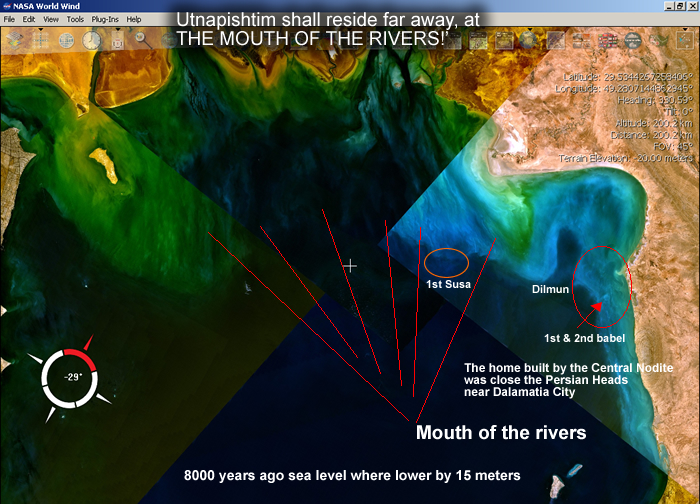
ancient Mesopotamia
Where is Genesis' Garden _in_ Eden?
The CONTRADICTING Mesopotamian myths reveal man was created in three cities, Eridu, Nippur and Babylon by the gods Enki (Ea), Enlil (Ellil) and Marduk (biblical Merodach).http://www.bibleorigins.net/DilmunTellelLahm2.html
Merodach (King James Version)
Isaiah 39:1 (Read all of Isaiah 39)
At that time Merodachbaladan, the son of Baladan, king of Babylon, sent letters and a present to Hezekiah: for he had heard that he had been sick, and was recovered.
How relevant is this verse to your query?Jeremiah 50:2 (Read all of Jeremiah 50)
Declare ye among the nations, and publish, and set up a standard; publish, and conceal not: say, Babylon is taken, Bel is confounded, Merodach is broken in pieces; her idols are confounded, her images are broken in pieces.
The Wall of Gorgon, the Kingdom of Arratta is to the east
Excavations In Iran Unravel Mystery Of 'Red Snake'
http://www.cais-soas.com/News/2008/February2008/20-02.htm
Sevens
The Aratta spole about in Sumerian tablets is the capital headquarters of the Van and then Adamson and his wife Ratta in Korason literaly. As I realised that description in Enmerkar and the lord of Aratta I found it fits this location with perfection.
Here is terrain layout of the location
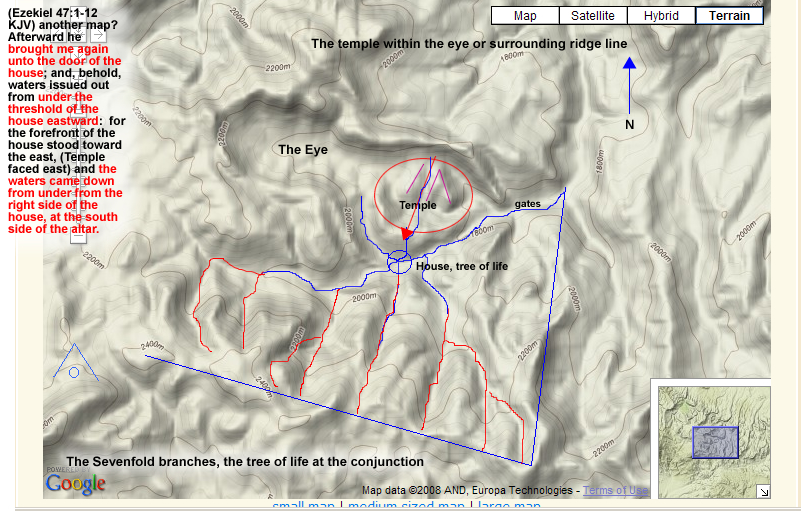
and here is a
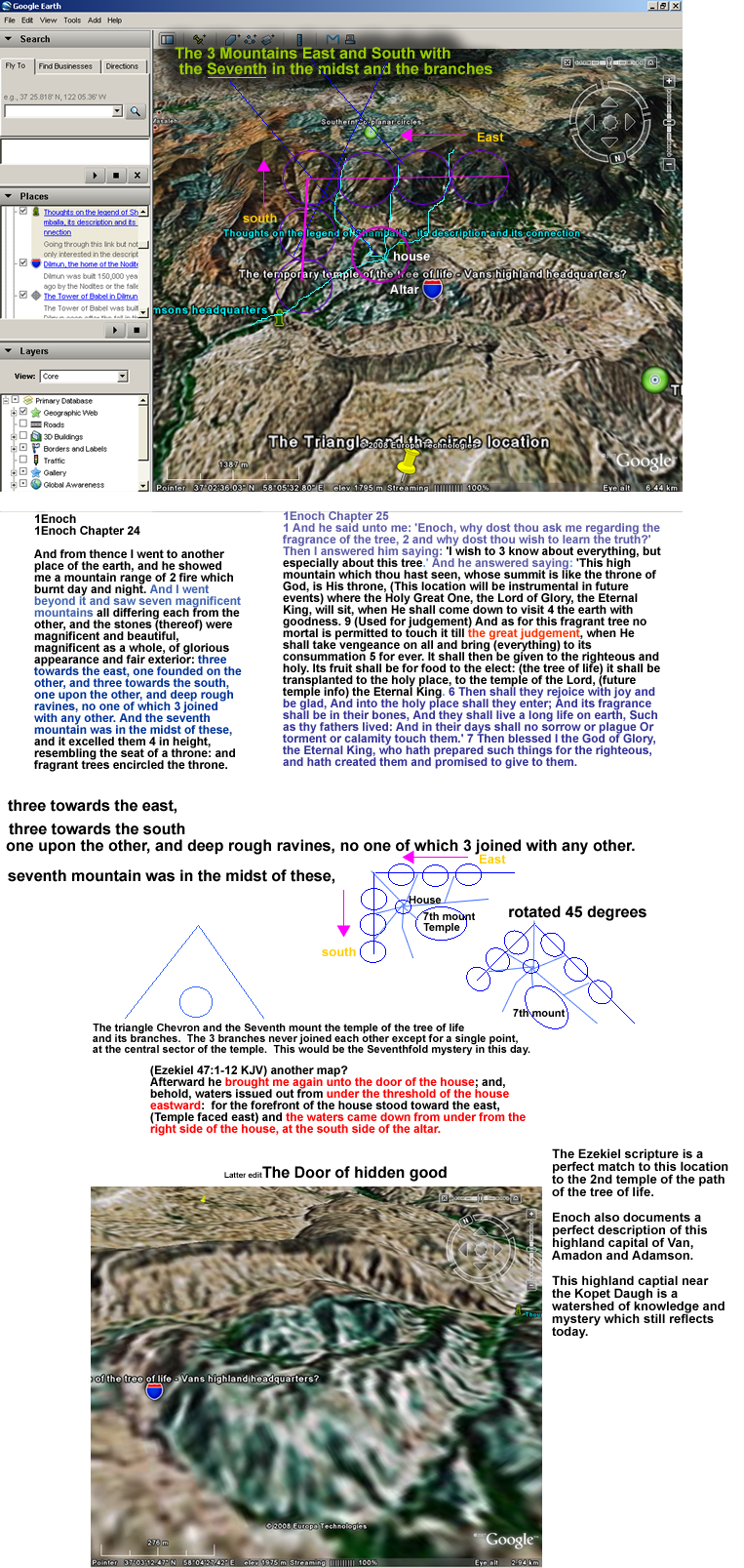
I believe it is through truth only and demonstrated that will kill Dajjal, the fallen son of God who brings division and I believe it may come from these ancient places and with a combined message for man.
There is so much more to this research but this give you some idea of what I am coming into and I hope it will be of benefit for all mankind.
Here is a fragment from what I discovered in some one elses research
|
|
|
|
||
|
|
|
|
||
|
|
|
|
It interesting to note that the Van/Adamson headquarters or
the Highland Capital of Aratta is on the latitude 37' 02 in the
highlands near the Kopet Daugh, North of the 36th latitude in Iran. A
fulfillment.
The written symbolism of this location of Aratta is
É - a r at t a - k i - s _ a' r - r a, "house, mountain of the
entire world"
Its a very beautiful journey to most beautiful ancient places.
http://cura.free.fr/xv/14boutet.html
Sevens
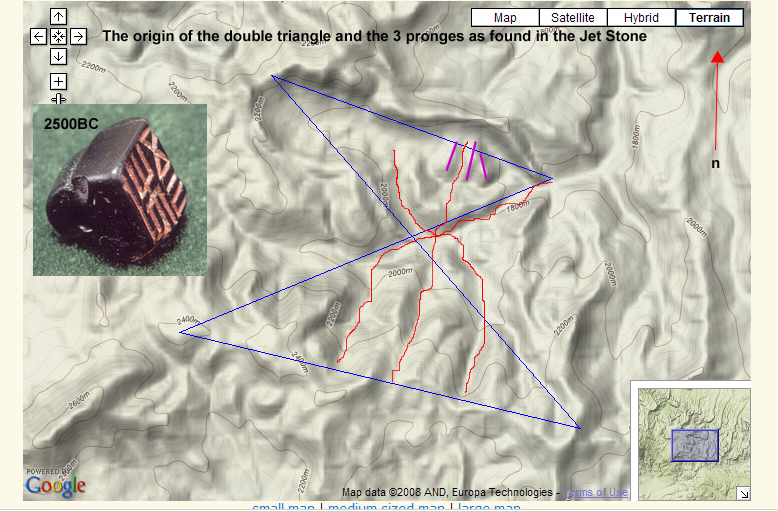
What comes out of Khorosan is part of a much wider and deeper presentation of our origins and journey of man and God working together in path not ever known before The Adamson civilization began 38,000 years ago and was a high culture for 7,000 years. Adamson and Ratta visited his Father Adam every 7 years in the 2nd Garden of Mesopotamia near ancient Babylon. The design of the Adais of the Mountain in Aratta can be seen in the parklands of Baghdad.

Whats even more interesting is the Symbol of this highland retreat in Iran displayed in ancient Babylon.

in Metaphor, its like the Father and the Son adamson next each other in symbolism. The Esagila contains the temple of Marduk which is the perpetuation Adam and the Zigurrat of Etemenanki, the Father. The kingdom of Aratta was named after his wife Ratta and the symbol is in ancient Babylon. The location of the Dais of the mountains.
Here is the Easgila, Yje temple of Marduk and the Ziggurat Etemenanki

Here is the written symbol of each of these locations combined discovered whilst following the symbols on the hidden path.
|
|
|
|
||
|
|
|
|
||
|
|
|
|
Sevens8
sevens


